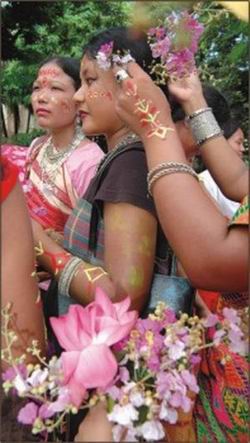Jasimuddin- Poet of the people of Bangladesh- A film by Khan Ata 1978
Our thousands of years of socio-cultural evolution and tradition, multireligious product and also multiracial expression are going to perish day by day. Many NGOs and donors spent millions of dollars to fight fanatism, racism etc in cities capitals with the elite of the society but it is a misuse of the money of the tax payers.It is just simple to forward rural women's culture!
'Nakshi Kantha' (Embroidered Quilt) makers of Pabna in dire straits
The makers of 'Nakshi Kantha' (embroidered quilt) in Pabna district are in dire straits in recent times.
The age-old glorious handicraft of the district is now facing extinction due to various problems confronting it. Lack of patronage is mainly responsible for the downslide of this handicraft.
It is gathered that a large number of women in all the nine upazilas of the district would once eke out a living by making and selling 'Nakshi Kantha'.
At least 600 women in rural areas of the district used to make 'Nakshi Kantha' by using old and new clothes, saris in particular. Women in groups used to sit in front of their verandahs and stitch kanthas by using old clothes, saris, lungis and bed sheets. They used to make attractive designs on the kanthas by using new clothes and colourful threads.
Amina Khatun of village Dasuriea in Ishwardi upazila told this correspondent that once she used to get a lot of orders for making 'Nakshi Kantha' and her income from it was substantial to maintain her family. Her mother and sisters-in-law were also connected with the trade, but these days she hardly gets any order.
Hafiza Begum of the same village said that in the past, housewives of rich families used to supply her with old and new clothes, threads to stitch varieties of kanthas. Those kanthas used to be given to their relatives, new-born babies, nieces and nephews as gifts. By stitching kanthas she used to earn Taka 25 to 30 every day and if she used materials at her own cost she used to earn Taka 600 to 700 per month. She used to meet the expenses of the family with the income, she said. But now it has become difficult for her to maintain her family. She has been forced to quit her age-old trade.
There is no patronage from the government to run the trade. Most of the women engaged in this trade are now leading a miserable life due to alarming fall in their income. The aggrieved women have urged the authorities concerned to provide them with loan on easy terms so that they can start their business afresh (The Independent, October 2, 2003).
Back to Content
3.Why Gold? Use Terracotta Jewellery
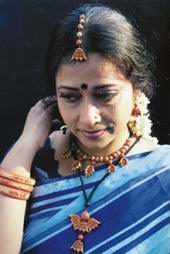 It's impossible to deny the fact that terracotta jewellery appears fashionable and looks just fantastic if you properly pair them with the right kinds of cotton saris.
If you are an avid fan of terra-cotta jewellery then it's time you took a look at the eye catching ornaments designed and crafted by Wahida Islam (Kakoli). It's been over 4 years that this housewife has been making jewellery from clay. She has participated in numerous fairs held by MIDAS, RAOWA Club, Officers' Club (Baily Road), SAARC Trade Fair etc and won praises of many.
It's impossible to deny the fact that terracotta jewellery appears fashionable and looks just fantastic if you properly pair them with the right kinds of cotton saris.
If you are an avid fan of terra-cotta jewellery then it's time you took a look at the eye catching ornaments designed and crafted by Wahida Islam (Kakoli). It's been over 4 years that this housewife has been making jewellery from clay. She has participated in numerous fairs held by MIDAS, RAOWA Club, Officers' Club (Baily Road), SAARC Trade Fair etc and won praises of many.
Wahida sells her jewellery from her home; a small, well decorated showroom at her very flat upholds a wide collection of jewellery of numerous patterns and colours. Her terracotta jewellery look elegant and unlike others they display colours ranging from blue, black, pink, green, and maroon, yellow and orange!
Wahida also makes stylish bridal terracotta jewellery sets, which you can buy on occasion of your sister or daughter's gaye holud(Engagement Festival)./p>
Among young girls, whose age usually ranges from 16 to 25 years, terra-cotta jewellery is extensively in style. Such jewellery not only harmonises with saris, but also complements salwar kameezs and cotton fotuas. So say goodbye to metal ornaments for a while and feel the charm of traditional terra-cotta jewellery. The store is situated House # 13, 3rd Floor, Road # 19, Sector # 11, Uttara, Dhaka.
(Wara Karim, October 12, 2004).
Glass Bangles - Churri
Bangles are a powerful style statement here in the Subcontinent. They are an integral part of the image of the quintessential Bangali belle, with her sari, her garlanded hair, and of course, her glass bangles.
The churri or bangle has evolved over the years, taking on many forms and designs to keep up with the whims of the fashion world, and it's still a reigning favourite. From traditional reshmi churris, to the chunky oxidised metal clasps, favoured by rock chicks, to the ethno-chic beaded beauties favoured by men and women alike, the bangle has worn many faces over the years, and now the good ol' glass bangles are making a strong comeback. Read on for a report on the current trends.
In Bangladesh snake charmers (gypsies) ply boat from one village to another and sell glass bangles since immortal time. This is a great pleasure for a village women, when she can buy bangles. Or it is a great surprise, when her husband brings beautiful glass bangel from village weekly hat bazar. The snake charmers sing:
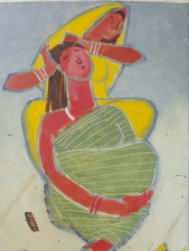 "O Babu, many salams to you
"O Babu, many salams to you
My name is Goya the snakecharmer,
My home is Padma river.
We catch birds
we live on birds
There is no end to our happiness,
For we trade
With the jewel on cora's head."
We cook on one bank,
We eat at another
We have no homes,
The whole world is our home,
All men are our brothers
We look for them
In every door….."
(Jasim Uddin)
 Glass bangles may have fascinated women in the past with their colours. But their colours or styles had never been so complex and fascinating like the ones available in the market now. And the market is booming.
Even a decade ago, glass bangles came in bland colours of green, black, red and yellow. The exotic ones were either imported from India or Pakistan. But now the country's Banglee artists themselves make complex ones with dazzling strokes of hues-- gold or silver and multicoloured patterns.
Local glass bangles are produced in various factories in Gazipur, Nawabganj, Lalbagh and Azimpur. The wholesalers sell these in a number of shops opposite a mosque in Chawkbazaar in addition to imported bangles from Pakistan and India.
Glass bangles may have fascinated women in the past with their colours. But their colours or styles had never been so complex and fascinating like the ones available in the market now. And the market is booming.
Even a decade ago, glass bangles came in bland colours of green, black, red and yellow. The exotic ones were either imported from India or Pakistan. But now the country's Banglee artists themselves make complex ones with dazzling strokes of hues-- gold or silver and multicoloured patterns.
Local glass bangles are produced in various factories in Gazipur, Nawabganj, Lalbagh and Azimpur. The wholesalers sell these in a number of shops opposite a mosque in Chawkbazaar in addition to imported bangles from Pakistan and India.
"Glass bangles have been in vogue since the British era and there is no substitute for them." said Gaza Mia, owner of Masud store, who is involved in the trade for 25 years. He also said that various shopkeepers from New Market and Gausia buy from his shop.
"Glass bangles are breakable, cheap and attractive so people tend to buy them for various ceremonies and even to decorate their homes." said Shamser, a salesperson from Shariful Store, who is involved in the trade for 16 years.
Bangles are really hot this season. This versatile accessory comes in a variety of shapes, colours and styles. You can wear it in different ways to dress up your attire. Wear a single, chunky metal clasp for that office chic. Jazz up that cotton sari with some colourful glass bangles, or, wear them with your jeans and fotua for a fun fusion look. Oxidised silver bangles are available in many funky geometrical shapes these days and look fab with shalwar kameez or your favourite casual wear. Experiment and play with different combinations to create a style of your own. The reigning theme this year is bold, bright, and utterly crazy (Sabrina F Ahmad and Sharmin Mehriban, September 6, 2005).
Back to Content
4. Mahatma Gandhi and Khadi: Protect a Dyeing Heritage
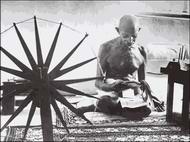 In 1921-22 Mahatma Gandhi and his followers were on a mission for peace and patriotism. Their approach was simple, as was their choice of attire. They embraced the rough textures of the spun cotton material known as khadi.
In 1921-22 Mahatma Gandhi and his followers were on a mission for peace and patriotism. Their approach was simple, as was their choice of attire. They embraced the rough textures of the spun cotton material known as khadi.
In the words of Gandhi, khadi is a fabric for human values and ethics. It delivers the people from the bond of the rich and creates a spiritual bond between the classes and the masses.
The creation of khadi follows a certain rhythm for which even an old woman who cannot see can sit and spin out the thread with utmost skill. A weaver can use that thread to churn out 8-12 yards of material. In return they get a stipend of 12 taka per yard. In cases where there are two designs on one cloth then they pay charges accordingly. Most of the khadi in the country is made from waste cotton. Now, the word 'waste' may sound bad, but in reality it isn't. It's more of recycling. You see, the textile mills discard a lot of cotton and this is used in turn to spin a thick thread
 Those who are involved with khadi are also facing many difficulties. Arun Guho, the country's primary khadi producer, explained that proper cash inflow is needed to keep the industry on a winning streak. Many times items are delivered on credit. Also the cotton required for production is often unavailable according to demand. As a result the workers have to make do with whatever is available. A continuous twelve-month work period cannot be maintained. Thread made with pit loom and power loom does not provide a good finish. Producers of khadi spend about eight months using thread from textile mills and the other four months using cotton threads. Despite the fact that some other producers are doing well using foreign yarn Arun Guho wants to stick to using local material.
Those who are involved with khadi are also facing many difficulties. Arun Guho, the country's primary khadi producer, explained that proper cash inflow is needed to keep the industry on a winning streak. Many times items are delivered on credit. Also the cotton required for production is often unavailable according to demand. As a result the workers have to make do with whatever is available. A continuous twelve-month work period cannot be maintained. Thread made with pit loom and power loom does not provide a good finish. Producers of khadi spend about eight months using thread from textile mills and the other four months using cotton threads. Despite the fact that some other producers are doing well using foreign yarn Arun Guho wants to stick to using local material.
Khadi and Cotton have always been in vogue; they are amongst those that will never go out of style. Khadi especially with its thick texture is not only fashionable, but ideal for the Fall season. Prabartana houses some of the most tasteful looking cottons and khadis in the city (Dhaka), and they do not compromise when it comes to quality. For Eid or Durga Puja, Prabartana has a display of very festive, bright coloured fabrics. Some of these luscious colours include royal blue, olive green, purple, indigo, maroon, chocolate, and burnt sienna to name a few. They have also kept a selection of cool, subtle shades such as sea-green, beige, mustard, onion pink and powder blue. Patterns are as much in abundance: Pin stripes, thick multicoloured or dual colour-coordinated stripes, plain checks, Nakshi Katha work over two-tone cloth, broken patterns of horizontal lines called 'Ikat' over tye-dye and Dobi stitchwork, are all available. Indulge yourselves in two, or four, or eight of these beautiful fabrics; even mix and match from the same materials, for instance, creating a pair of shalwaar, pants or capris with the thicker Khadi, and fatuas, short and normal length kameezes with the finer, softer khadi. (You could add beadwork on your khadi and cotton kameezes to make them different; transparent and multi-coloured beads may be found in abundance at New Market.) Complete your look with a trendy Prabartana dupatta. These come in many different shades and designs as well, some of which include shocking pink in checks, peacock blue in stripes; two-tones such as beige and pink, sea-green and blue, are also available. Why stop at wearing dupattas the traditional way?
In our country Shoilen Guho is considered as the pioneer of the khadi creations and was known as Khadibabu. During his school days in Chittagong he took a deep interest in the creation of this material. The carpus cotton of Rangamati was spun into fibre for all kinds of ropes, strings and fishing nets. At that time one of the landlord's sons came back from abroad and set up a weaving factory. Shoilen Guho learnt the rest of his trade at the factory.
The cotton needed to be soaked overnight and later would be treated with starch before being put on the loom. Around 1931, during his teen years, khadi was a very popular material. Shoilen was so into the craft that he used to gather the thread from surrounding villages and spin and sell his own cloth. At the same time he used to work at the Chittagong National Textile Mill as the dyeing master. What he learnt there regarding the coloring of cloth served as an invaluable experience later on.
Abhoy Asram in Chandinath, Comilla was a centre for spinning yarn. Warda cotton was used for this purpose, resulting in a much better product. Shoilen spent a lot of time there to create and promote khadi as well as to educate and train the locals in the art of spinning. His business expanded, as there was a boom in the demand, and he started supplying his products to Calcutta. It reached a high with a conference featuring the textile, which was directed by Shoilen.
Despite the popularity, the hand-cut material could not catch on in the market at the time.In the 50's khadi had risen high in the Indian market due to intense promotion. The quality improved greatly with government aid and a lot of effort on the personal level. Comparatively that did not seem to happen in our country. Shoilen and his fellow craftsmen produced enough to meet the market demand but khadi could not take over the market from the other cloths although it came to a lot of uses and was inexpensive.
The following years of the Liberation War saw a rise in patriotic feelings. Joblessness brought about many entrepreneurs and some of them started promoting home made clothing with the aid of khadi.
People prefer to use natural and ecologically friendly materials like khadi. She (Bibi Russel) is endeavouring to further the work that Shoilen Guho started and also trying to protect the Comilla khadi society. She also said that nowadays, real khadi, whose threads used to be a little thicker, is no longer prepared. It had its own elegance. At present khadi is made with mixed fibres (Bibi russeland Sultana Yasmin October 2004).
Khadi Cottage Industry in Commilla
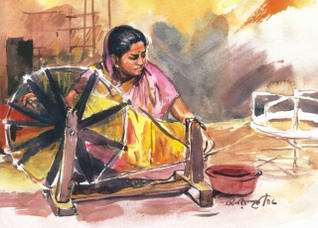 Comilla has been playing an influential role in creating woven crafts since the days of the Mughals. There were numerous weavers in the Tripura state during the 17th century. The 1890 Tripura Gazetteer tells us that a woven craft existed in the area which employed thirteen thousand men and two thousand women weavers.
Comilla has been playing an influential role in creating woven crafts since the days of the Mughals. There were numerous weavers in the Tripura state during the 17th century. The 1890 Tripura Gazetteer tells us that a woven craft existed in the area which employed thirteen thousand men and two thousand women weavers.
The 1890 Tripura Gazzetteer tells us that a woven craft existed in the area which employed thirteen thousand men and two thousand women weavers. Among them most were Hindu in religion and came from Mainamoti, Chandina, Gauripur, Nobinagar, Kalikachha, Dhamti and Borkamta. In Mainamoti were made brightly coloured lungies in check design as well as sarees and gamchhas.
These cost between taka two and five in the currency of that time. The weavers from Shorail, Kalikachha and Nabinagar used to make very good quality dhuties and bed sheets. These used to cost from taka two to five a pair depending on their quality.
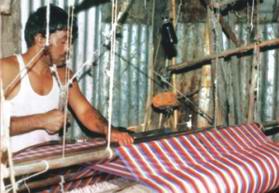 Comilla has been playing an influential role in creating woven crafts since the days of the Mughals. There were numerous weavers in the Tripura state during the 17th century. The 1890 Tripura Gazetteer tells us that a woven craft existed in the area which employed thirteen thousand men and two thousand women weavers. Among them most were Hindu in religion and came from Mainamoti, Chandina, Gauripur, Nobinagar, Kalikachha, Dhamti and Borkamta. In Mainamoti were made brightly coloured lungies in check design as well as sarees and gamchhas. These cost between taka two and five in the currency of that time. The weavers from Shorail, Kalikachha and Nabinagar used to make very good quality dhuties and bed sheets. These used to cost from taka two to five a pair depending on their quality. Woven craft was mainly concentrated within the areas of Moenamoti, Muradnagar, Gauripur and Chandina. These weavers who had been practising this craft for generations were apt in this field long before the craft became famous in Europe. Even when the demand for material imported from London and Manchester was high, the demand for material woven within the country remained unaffected. Apparels of modern design were made from the posh imported material whereas the everyday clothing of the people of the country, such as dhuties for Hindus and lungies for Muslims, were made from our own material.
Comilla has been playing an influential role in creating woven crafts since the days of the Mughals. There were numerous weavers in the Tripura state during the 17th century. The 1890 Tripura Gazetteer tells us that a woven craft existed in the area which employed thirteen thousand men and two thousand women weavers. Among them most were Hindu in religion and came from Mainamoti, Chandina, Gauripur, Nobinagar, Kalikachha, Dhamti and Borkamta. In Mainamoti were made brightly coloured lungies in check design as well as sarees and gamchhas. These cost between taka two and five in the currency of that time. The weavers from Shorail, Kalikachha and Nabinagar used to make very good quality dhuties and bed sheets. These used to cost from taka two to five a pair depending on their quality. Woven craft was mainly concentrated within the areas of Moenamoti, Muradnagar, Gauripur and Chandina. These weavers who had been practising this craft for generations were apt in this field long before the craft became famous in Europe. Even when the demand for material imported from London and Manchester was high, the demand for material woven within the country remained unaffected. Apparels of modern design were made from the posh imported material whereas the everyday clothing of the people of the country, such as dhuties for Hindus and lungies for Muslims, were made from our own material.
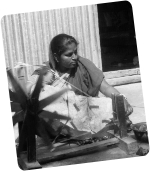 Apart from Comilla's legendary woven art, the khadi work of this area is of a quality good enough to compete with any type of cloth from any part of the world. Mahatma Gandhi's exemplary principles and protests against foreign cloth inspired the initiation of Khadi work in Comilla. A branch of the Nikhil Bharat Tantubai Samiti was founded in Comilla which helped promote the exceptional products of the Khadi industry in Kolkata, Mumbai and Chennai.
After the partition of India in 1947, Khadi work was almost on its way to extinction due to various changes in the political and social environments. Comilla also suffered the effects of those changes.
Apart from Comilla's legendary woven art, the khadi work of this area is of a quality good enough to compete with any type of cloth from any part of the world. Mahatma Gandhi's exemplary principles and protests against foreign cloth inspired the initiation of Khadi work in Comilla. A branch of the Nikhil Bharat Tantubai Samiti was founded in Comilla which helped promote the exceptional products of the Khadi industry in Kolkata, Mumbai and Chennai.
After the partition of India in 1947, Khadi work was almost on its way to extinction due to various changes in the political and social environments. Comilla also suffered the effects of those changes.
Pradip raha, now nearing the age of 58, lives in Comilla and is known for his business of Khadi material. Tourists from within the country and abroad visit his store of pure Khaddar material whenever they go to Comilla. There is nothing unworthy of being bought at his store. Pradip Babu tried his hand at the weaving industry but he now prefers to deal with Khadi materials. He says that there is still a lot of demand for this particular type of material, especially because clothes made with this material are now being made in newer and more modern designs.
When asked if the prices have risen compared to what they used to be, he says that it is natural with time. Materials have become much costlier than they used to be. For instance, a khadi dress that could be purchased at a certain price now, one could buy more than one dress at the same price before. There are a lot of reasons behind this, like lack of good quality labor, electricity load shedding and a rise in the general price of things. He says that even though a number of many competent weavers had left Bangladesh after the liberation war, there are still many highly skilled weavers who do good work, even with no formal training of the art.
In fact, none of the weavers in Chadinar village has any formal training. All they possess is experience acquired over time. It is really amazing to see how impressive their intricately woven clothes are. With time, the girls in the family also started to work as weavers. However, Khadi work is done only by aged and experienced weavers. Thread work designs and hand paintings are mainly done by women.
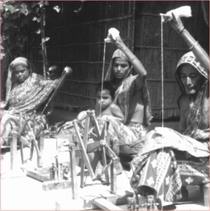 After the liberation of Bangladesh, Khaddar work again flourished and made a name both at home and abroad, making its home district Comilla wellknown and famous all over. The weavers of Comilla have kept up with the changes in design with time, and they now follow the modern designs of Madras and Bombay Corporationss to keep their work up-to-date and suitable for the current styles of clothing. This has brought a touch of modernity to the ageold khaddar art of Comilla. A few names that must be mentioned when speaking of Khaddar art of this region are Prabodh Das, Taruni Mohan Raha, Dinesh Babu, Manmohan Dutta, Shantosh Dutta, Samar Majumdar, Swapan Majumdar, Bahar Mia, Jairam Shaha, and Shankar Babu. These persons have been related to the Khadi industry by family tradition and they have relentlessly worked to keep this art alive and vibrant.
After the liberation of Bangladesh, Khaddar work again flourished and made a name both at home and abroad, making its home district Comilla wellknown and famous all over. The weavers of Comilla have kept up with the changes in design with time, and they now follow the modern designs of Madras and Bombay Corporationss to keep their work up-to-date and suitable for the current styles of clothing. This has brought a touch of modernity to the ageold khaddar art of Comilla. A few names that must be mentioned when speaking of Khaddar art of this region are Prabodh Das, Taruni Mohan Raha, Dinesh Babu, Manmohan Dutta, Shantosh Dutta, Samar Majumdar, Swapan Majumdar, Bahar Mia, Jairam Shaha, and Shankar Babu. These persons have been related to the Khadi industry by family tradition and they have relentlessly worked to keep this art alive and vibrant.
Comilla's Khaddar is now well-known all over the country which is why we see so many stores that sell Khaddar material. The material is also sold in stores in markets like Gariahata in Kolkata. A new Khadi Market has been set up in Monohorpur of Comilla and on the Kandipara-Laksham Road. And even though the Khadi market called Bay-land shipping center is small in size, numerous customers come and buy from there Khaddar materials that suit their tastes (Zakir Azad, November 25, 2006).
Back to Content
5. Hungry Weavers
Silent shuttles keep weavers hungry 50,000 flood-damaged handlooms in Tangail cannot be reactivated for want of loan
Netrakona: The shuttles are still silent. Weavers ponder how to reactivate those.
This is the scene in most weavers' villages in Tangail, a district known for handloom products.
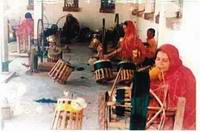 The poor weavers said they do not have capital to repair the flood-damaged handlooms and buy yarn and other raw materials. Most of then said they ate up the capital for survival during the recent deluge for a month and a half.
The floods silenced about 50,000 weaving factories in Kalihati, Delduar, Ghatail, Nagorpur and Madhupur upazilas as most areas there were inundated. Kalihati and Delduar upazilas were the worst affected.
The poor weavers said they do not have capital to repair the flood-damaged handlooms and buy yarn and other raw materials. Most of then said they ate up the capital for survival during the recent deluge for a month and a half.
The floods silenced about 50,000 weaving factories in Kalihati, Delduar, Ghatail, Nagorpur and Madhupur upazilas as most areas there were inundated. Kalihati and Delduar upazilas were the worst affected.
Weaving is the main profession of most of the people in Balla, Singir, Behulabari, Kazibari, Borotiabari, Momin Nagar and Khasia villages in Bala union; Kokdhram, Tenguria, Utrail and Dandagram in Kokdhora union; Nagbari, Kadim, Khasila, Gachina, Tajpur, Birpukutia and Borobari in Nagbari union; Koloha, Ruayel and Satihati in Paikura union and Akua and Chamuria villages in Sadebpur union in Kalihati upazila.
During a recent visit to the areas, weavers said about 80 per cent handlooms in the area, which were closed due to stagnant floodwater, are yet to be reactivated. The number would be around 30,000, they estimated.
Same is the condition of about 20,000 handlooms in Ghatail, Nagorpur, Delduar and Modhupur upazilas.
Some sources estimated the weavers' total loss at around Tk one crore.
The factories can not be re-opened as equipment like 'Tana' and 'Zu' have been damaged and lack of capital to buy raw materials.
As most of the people in these upazilas depend on weaving, they have been exposed to utter misery. Small weavers having no land are hard-hit.
Amena Begum of Gunipara village in Nagarpur upazila said she has five handlooms. She produced gamcha, lungi, and bedsheet and maintained her family.
The flood damaged her five handlooms. She has not work now. She went to different banks for loan but did not get.
Fatema Khatun of Ghatail has six handlooms. She sold a small land and is trying to start the business. She could not manage loan from any bank or NGO.
There are many like Amena and Fatema in the villages.
They said NGOs like Karitas, World Vision and BRAC do not give them any loan (Daily Star September 27, 2004).
The country’s handloom industry is on the verge of destruction amidst mounting sufferings of the weavers in the wake of recent floods as the government is yet to come up with a package of incentives to put the traditional industry back on track.
Only one lakh VGF (Vulnerable Group Feeding) cards have so far been issued among the weavers in six districts but the number of the affected weavers is about 5 lakh (The Independent, November 24, 2004).
Women, weavers and woes
Thangamara, lies 6 km north of Bogra town and just beside the Dhaka-Rangpur highway, where about 1,500 women of the organisation are employed in weaving, processing of yarn and dyeing of fabrics. These women, reportedly, come from very poor families -- mostly from the "unheard and unsung" segment of the society. Some of them are widowed, some divorced and others reeling under the shadow of separation. In conventional concept of poverty, they could possibly be dubbed as the "extreme poor" population. Their monthly income hovers around Tk.
1000-1500 to put the poor on an uneven keel. They can hardly send their children to schools, care for illness and cope with the contingent crises.
The quality of the processed yarn and fineness and look of fabrics that follow from dyeing, needless to mention, go to determine the quality of the output sold and the consequent competitiveness in the market. The processing and dyeing, disconcertingly, take place through the use of traditional support items like firewood, coals and others. Allegedly, the heat cannot be controlled, so the distribution of colour gets skewed at times to tell upon the quality of the fabric. The management informed me that in case gas could be available, their cost of production could come down by as much as 40 per cent from the present level of processing and dyeing costs. Further, the resulting improvements in the quality of the product and lowering of prices would inject a demand for the products and hence a demand for the services of the women working there. This would also allow a diversification of products as clean energy would enable a quick completion of the tasks. That would also help them dry the fabrics, if and when needed. I was told that gas access to such activities would raise the income of these distressed women by 10-15 per cent, on average.
Belkuchi upazial lies in Sirajgonj district. The place is famous for handlooms. I am told that there were about 30-40 thousand weavers in this upazila but competition from modern textiles laid off half of them. About 60 per cent of the weavers are poor (owning on average 2-3 looms). My recent visit with my young friend Habib revealed to me the reeling conditions under which they are operating. Tree covers were being used. Now trees are uprooted and felled and deforestation is looming large. Use of coals is causing health problems and environmental pollution. The weavers, processor and dyers have been struggling for a long time to have access to gas facilities. According to the weavers -- mostly poor -- the access to gas would reduce the cost of processing and dyeing by about 50 per cent. That would also help raise the quality of the product and open up the door for diversification of products. Gas access to that area could possible bring back some of the weavers in the realm reducing their woes. The gas demand for that particular village could exceed the total demand of households in Sirajganj district.
Rich or poor, all the weavers were eagerly waiting for a connection to their households and loom houses. Besides benefiting from clean and less costly energy used for cooking purposes, the weavers could grow competitive by producing good quality varieties of products. Their willingness to pay for connection ranged between Tk.50,000 for the rich to Tk. 20,000 for the poor (but with installments for borrowed funds). Poor weavers would welcome alternative arrangements of funds that could be recouped through their savings on account of energy costs.
There are millions of cottage and small industries in Bangladesh, run by the poor either as worker or owners, which are being forced to be out of the market due to high production costs. Say, a ceramic factory in or around Dhaka run by gas is more cost effective than the same in Bogra run by traditional fuels. In fact, one famous ceramic factory in Bogra was closed down due to failure to meet competition. The poor production workers are now forced to face the problems of food in security.
We, therefore, need to take into careful cognisance the ramifications of gas supply for the poor. It is not only at household level but also at commercial and industry levels that access to gas could go a long way in poverty reduction. Gas gears up growth through production of fertilizer and generation of power. But the direct impacts need to be reckoned with in the event of demand analysis. Let me conclude with the comments from a poor weaver: "Gas is like electricity. Once it comes to the neighbour, I feel an urge to have it no matter at what cost". This seemingly says that gas could be correlated with women, weavers and their woes!,(Abdul Bayes, Professor of Economics at Jahangirnagar University, Daily Star, December 7, 2004)
Back to Content
6. Shangkha Shilpa: A diminishing craft
The shankha, or conch shell, is considered especially sacred. Of the two kinds of shankhas that are found in India, the 'dakshinavarta' is open on the right and its thinner end curves to the right, while the 'namavarta' opens towards the left with its thinner end also curving left. The dakshinavarta is rarely found and considered very lucky. It is said to bring wealth to whoever possesses it.
Shankhas are also classified by caste. White shankhas are usually owned by Brahmins, red or brown ones are meant for Kshatriyas, yellowish ones for Vaishyas, while Shudras usually own grey and black shankhas.
The shankha is blown before the start of most ceremonies. Its sound is said to symbolise that of the cosmic universe.
In ancient India, the shankha always went to war: it was blown at sunrise to indicate the beginning of the day's battle and sounded again at sunset to end fighting. Warriors also blew the shankha to announce their victory.
The Ramayana, Mahabharata, Tantric texts, and secular literature all eulogise the shankha. Various deities are believed to live in its different parts: in the front end resides the moon, in the hollow sides, Varuna, at the back, Prajapati, and in the lip, the rivers Ganga and Sarasvati. The shankha is one of the four attributes that Vishnu holds in his hands. In Tantric belief, the shankha keeps away evil spirits and saves mankind from calamities.
The shankha is believed to be one of the treasures that emerged in the samudra manthan, and part of its evocative mystery is the sound of the sea (some say, the primordial ocean) that it always carries within it.
 Shanku is the divine Counch or sea shell, which is one of the insignia in the Hindu God Vishnu's hands. Lord Vishnu, also called Narayan, is imagined to have four hands. He has a Shankha (a conch shell) on one hand, the Sudarshan in second, Gada (a mace) in third and Padma (lotus flower) in the fourth.
Lord Vishnu is imagined to hold the Shanku on his upper left hand. The Shanku is used to alarm enemies and to start off war. It also represents awakening. The sound emitted from Shanku when blown, is too divine, that is used for regular rituals for Vishnu. Shanku also represents the Insignia of Vishnu. As a result of this, Shanku stands as a Royal State Emblem of Travancore and current state emblem of Kerala.
Shanku is the divine Counch or sea shell, which is one of the insignia in the Hindu God Vishnu's hands. Lord Vishnu, also called Narayan, is imagined to have four hands. He has a Shankha (a conch shell) on one hand, the Sudarshan in second, Gada (a mace) in third and Padma (lotus flower) in the fourth.
Lord Vishnu is imagined to hold the Shanku on his upper left hand. The Shanku is used to alarm enemies and to start off war. It also represents awakening. The sound emitted from Shanku when blown, is too divine, that is used for regular rituals for Vishnu. Shanku also represents the Insignia of Vishnu. As a result of this, Shanku stands as a Royal State Emblem of Travancore and current state emblem of Kerala.
Dhaka was once renowned for Shankha Shilpa, the art of making bangles and other kinds of ornamental adornments from conch shells. Originally centred in Shankari Bazar in the Old Town, the area had been home to these artisans for centuries. It was an affluent, vibrant locality in old Dhaka until most of it was destroyed by the Pakistani army in 1971. The artisans have rebuilt their houses and businesses since, but the rich lustre of the bygone days is missing,
This delicate art, shangkha shilpa, is so time-old that archaeologists suggest images of the conch shell bangles and the like as evident in terracotta art, much earlier than the 17th century. The karigars or workers of shangkha shilpa, are traditionally called shangkha banik. James Wise (1883) had written about the shakharis and recorded in his journal that of the total 11,453 artisans, 835 used to live in old Dhaka.
Legend has it that the shankaris arrived with Ballal Sen in then Banga (East Bengal) and settled in Bikrampur, southeast of Dhaka. In the latter years of the 17th century, the Mughals brought them to Dhaka with the assurance of such endowments as lakheraj land (free land). Even the houses in the area have the characteristics of their own which are still evident in many of the structures. The freehold land allotted to the artisans was like a strip—narrow and long. The structures built on the narrow slices of each plot have had a frontage with a façade not more than six feet wide and a small front door; slim and long corridors—ten twenty to thirty yards in length. The corridors will lead to the stairs running along to climb the three or four storied houses. Almost every house has a tiny central courtyard. A number of these time-old structures were destroyed in a recent collapse because of the impermissible load of constructions on top of the buildings. Most of them are quite unsafe to live in.
From the very beginning the Shankha business was centred in Shankhari Bazar. Now, it has been decentralised, as the government has started giving licence to other artisans, shankharis in other districts can import conch shell and set up the business individually. The dispersal of business has ended the monopoly of Shankhari Bazar in the trade, reducing the residents and the businesses drastically even for family upkeeps. ‘This is another cause of the decline of Shankhari Bazar,’ said one of the proprietors. According to the Shankhari Bazar Shangkha Shilpa Karigar Samity, the organisation for the dwellers of Shankhari Bazar, there are at present 36 proprietors, owning fifteen shops, with a total number of 104 workers employed by them.
Besides the obligatory wear of Shankhgas or bangles made from conch-shell for the married Hindu women, a sign negating widow-hood, the Shankharisa , as stated before made all kinds of ornamental products for women’ wear. But with the change of time and taste, ornaments made from other materials than precious metals or gems or stones, have made inroads rendering the Shankharti products of earrings, necklaces and other wears literally obsolete. Even a couple of years back the shankharis used to make earrings, necklaces and other attractive ornaments from shells but now they are confined to only making shankhas or bangles. ‘The use of conch shell should not be only restricted to the Hindu community. Women, irrespective of creed or caste, can use this traditional handicraft to adorn themselves and even the showpieces made from conch shells can be used in the house. In fact, the products can be made popular among people of all communities,’ says Amiya Kumar Sur, owner of the New Lakhmi Bhandar, one of the fifteen shops specialising in only conch shell ornamental products.
Though the cottage industry of conch shell has also flourished in Sri Lanka and in the southern parts of India, the Hindu women in those areas do not use shankhas. This is unique to the Bengali Hindu women when it comes to marital culture. According to Hindu belief, the shankhas are supposed to keep the mind and body cool and some of the conch-shell elements like carbon protect women from diseases, it is believed.
Only around 150 families are in the industry at present. Since the early 90's the numbers are decreasing while the new generation is not keen to enter the profession.
"We have only 10 workers here at present and each earns just Tk 70 to 100 a day. In the late 80's we were more than 70 workers and were earning Tk 200 to 250 each per day," said Haridas Dutta, a worker in the sole conch-shell cutting factory in Shankhari Bazar.
"The 30 to 35 existing shankha business houses in Shankhari Bazar are dependent on this factory for cutting. And this low volume of work-pressure shows how the business is deteriorating," said Omio Kumar Soor, treasurer, SSKS.
Customers blame high prices as the reason for the lack of interest in purchasing shankha.
"I bought only one pair of shankha on the eve of Durgapuja, but when prices were low, I bought them many times a year," said Roma Das, a Shankhari Bazar housewife.
Some craftsmen are still fighting to save the shankha industry by making various other items from conch-shell along with shankha.
Shankhari Bazar Shangkha Shilpa Karigar Samity’ has abandoned the age-old manual saw and has taken up electric saws since 1990.
Sadly, the karigars have lately been switching to other professions. The sound of the ‘shankher karat’ (conch saw), by which the conch is cut, in Shankhari Bazar, the home to the trade, is lately being drowned by the blare of film music, masonry works and other sounds causing noise pollution. Of the original 142 shankha shops of the lane, only 15 are committed to the art today.
Cool conch bangles
The proverbial Shankher Karaat, a double-edged saw, is no longer found in Shankhari Bazar in Old Dhaka or anywhere else, for that matter. But that did not stop the artisans who have been in this trade for generations.
Artisans who inherited the craft from their ancestors are now using electric blades in crafting conch bangles.
"Shankha crafting is a fourth generation profession for me," says Nakuneswar Naag.
Shankha of Shakharibazar is unique, compared to other places like Tangail, Khulna and even India. Its design, elegance, variety and craftsmanship are superb.
Shankha is the symbol of marriage for Hindus. Hindu women wear shankha for the welfare of their husbands, they believe. So, the shankha market sprang up some centuries ago. Modern women wear shankha as ornaments.
Carving bangles out of conch shells is like making a sculpture out of stones. Seven different artisans pull off their mastery to produce a finished product.
"The raw material, the conch shell, is not available in Bangladesh. We import it from Sri Lanka," says Nakuleswar.
"India does produce some shells too, but the quality isn't that good."
The price for the raw conch shells ranges between Tk 19,000 and Tk 29,000 a sack, depending on size, weight and quality.
They produce two kinds of shells; kari, weighty and firm, and jhanji, softer and naturally designed.
"Firstly, we break the tail end of the conch and get the softer part out of the shell," describes Ashish, a conch artisan. "Then we break the upper portion of the shell."
"People from some herbal medicine shops take that peta, the dead body, to make medicine for liver diseases," explains Swapan, a conch breaker. "So, the wastes of shells are not at all a wastage. Even the dust of shell is sold Tk 2 per tola. People use that to remove the scars from faces."
"Then we wash the shells several times for a good clean," says Ashish. "The most difficult task comes next, to cut the conch into bangle shape and to make the most use of the shell without damaging the body."
"The bangles are then designed with various motifs. Designers create the patterns of on the bangle according to its size, depth and density.
Back to Content
7. Weaver Bird (babuipakhi) - A big success
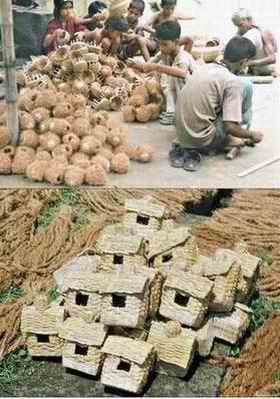 In Sitarampur Rishipur village district Jessorem a family is making bul bul netz and found market all over the world. Bul Bul birds are very popular in Bangladesh, which make most ornamented netz in palm trees.
In Sitarampur Rishipur village district Jessorem a family is making bul bul netz and found market all over the world. Bul Bul birds are very popular in Bangladesh, which make most ornamented netz in palm trees.
Bagichai Bulbuli tui phul shakhatey dishney aji dol...
or Bulbuli nirob Nargis boney ...
these few lines of the songs by our National poet Kazi Nazrul Islam always stir the minds of music aficionados. Those lines make us visualise the poet's warm association with nature's wonderful creation- red vented Bulbul. The nests were mostly very compact and rather deep cups about 3½ inches in diameter and 2 inches in height, very firmly woven of moss and grass-roots, but with a certain quantity of dry and dead leaves, and here and there a little cobweb worked into the outer surface. Sometimes a little fine grass was used as a lining; but generally there was no lining, only the roots that were used in finishing off the interior of the nests were rather finer than those employed elsewhere. The egg-cavity is very large for the size of the nest, the sides, though very firm and compact, being scarcely above half an inch in thickness. The nests differ very much in appearance, owing to the fact that in some all the roots used are black, in others pale brown (Molpastes bengalensis (Blyth). Bengal Red-vented Bulbul).
Otocompsa emeria (Linn.). Bengal Red-whiskered Bulbul,
Otocompsa jocosa (Linn.), Jerdon B. Ind ii,
Otocompsa emeria (Shaw), Hume, Rough Draft N.& E.
The Bengal Red-whiskered Bulbul breeds from March to the end of May. Its nest is placed, according to my experience in Lower Bengal, in any thick bush, clump of grass, or knot of creepers; sometimes in the immediate proximity of native villages or in the gardens, and sometimes quite away in the jungle. It is a typical Bulbul nest, a broad shallow saucer, compactly put together with twigs of herbaceous plants, amongst which, especially towards the base, a few dry leaves are incorporated, and lined with roots or fine grass. Exteriorly a little cobweb is wound on to keep twigs and leaves firm and in their places.
Threatened birds are found virtually throughout India. Forests in the Western and Eastern Himalayas support groups of species with small and declining ranges, including several partridges and pheasants. The recently rediscovered Forest Owlet inhabits a few forest fragments in Central India, and a group of birds endemic to the Western Ghats are also globally threatened.
The grasslands and wetlands of the northern plains are strongholds for birds such as Bengal Florican and Greater Adjutant. Grasslands and semi-deserts in eastern India are vital for Great Indian Bustard and Lesser Florican, and arid thorn forests in the south support the poorly known Jerdon’s Courser and several other threatened birds.
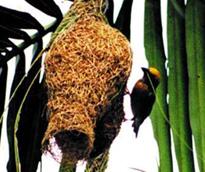 Birds like weaver-bird (Babui) and tailor-bird(Tuntuni) themselves are very big artists. Weaver Bird (babuipakhi) sparrowlike birds of the family Passeridae, order Passeriformes. The bird is known from its elaborately interwoven nests and locally familiar as babui or baoi. The males are often conspicuously coloured. Most species of this group of birds live in Africa, a few in Asia and Australia. Weavers are so called because their nests are made from leaf fibres woven together like a basket. The hanging nests have complex entrance tunnels. There are about 117 species of weavers worldwide; Bangladesh has three species.
Black-breasted Weaver (Ploceus benghalensis): in breeding season males have brilliant golden-yellow crown, white throat and a black band separating it from the fulvous-white underparts. In non-breeding male and female, crown brown like rest of upper plumage; black pectoral band less developed. A prominent supercilium, a spot behing ear, and narrow moustachial streaks, pale yellow. Found in flocks.
Streaked Weaver (Ploceus manyar): breast fulvous, boldly streaked with black in both sexes and at all seasons. Crown of head in breeding males yellow; in females and non-breeding males brown. Flocks are found in swampy tall reed-beds.
Baya Weaver (Ploceus philippinus): male and female in non-breeding plumage: dark-streaked fulvous brown above, plain whitish fulvous below. Bill stout conical; tail short square-cut. Breeding male has bright yellow crown and upper parts dark brown streaked with yellow. Yellow breast, cream buff on underparts. Flocks are found in open cultivation.
Birds like weaver-bird (Babui) and tailor-bird(Tuntuni) themselves are very big artists. Weaver Bird (babuipakhi) sparrowlike birds of the family Passeridae, order Passeriformes. The bird is known from its elaborately interwoven nests and locally familiar as babui or baoi. The males are often conspicuously coloured. Most species of this group of birds live in Africa, a few in Asia and Australia. Weavers are so called because their nests are made from leaf fibres woven together like a basket. The hanging nests have complex entrance tunnels. There are about 117 species of weavers worldwide; Bangladesh has three species.
Black-breasted Weaver (Ploceus benghalensis): in breeding season males have brilliant golden-yellow crown, white throat and a black band separating it from the fulvous-white underparts. In non-breeding male and female, crown brown like rest of upper plumage; black pectoral band less developed. A prominent supercilium, a spot behing ear, and narrow moustachial streaks, pale yellow. Found in flocks.
Streaked Weaver (Ploceus manyar): breast fulvous, boldly streaked with black in both sexes and at all seasons. Crown of head in breeding males yellow; in females and non-breeding males brown. Flocks are found in swampy tall reed-beds.
Baya Weaver (Ploceus philippinus): male and female in non-breeding plumage: dark-streaked fulvous brown above, plain whitish fulvous below. Bill stout conical; tail short square-cut. Breeding male has bright yellow crown and upper parts dark brown streaked with yellow. Yellow breast, cream buff on underparts. Flocks are found in open cultivation.
Tuntuna and Tuntuni
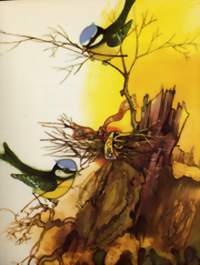
There were once two tailor birds called Tuntuna and Tuntuni....
One day Tuntuna said to his wife. "My dear Tuntuni, I wish I had some money...." After many days of searching, he found a pence under a bush. He took it in his beak and carried it to Tuntuni.....
"Tuntuni, we have become rich!".....
They were so happy that they forgot about eating and sleeping. They just danced and singing:
"How much money does the king have?
That's how much money we have"
....When the king heard the words of the birds and made him very angry and ordered to catch them immediately.....
The commander of Chief at last with the help of the fishermen caught the birds.
The king gave the birds to his 101 queens...The birds were passed from one queen to another. The lazy queen did not hold the bird tightly, and first Tuntuna then Tuntuni flew out of her hands.....No one of the queens dared to tell the king what had happened.
... The next day, the king call all the wise men in the land to his court to judge the Tuntunis...
The king ordered the birds to be brought into the court. He waited and waited, but the Tuntunis did not come....
Suddenly, the Tuntunis came flying over the king's head.. and singing:
"Tuntuna, Tuntunni,
Tuntunis tun tun!
All the queens noses
Are as red as roses!
Tun tun, tun tun, tun tun."
The king could control his anger. "Catch those Tuntuni bird," he shouted....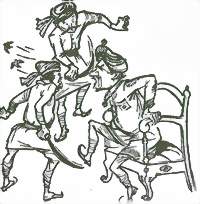 Soon the two birds were caught in the nets, but this time the king would not wait for his wise men to judge them. He took a glass and swallowed tuntuna and tuntuni.
Soon the two birds were caught in the nets, but this time the king would not wait for his wise men to judge them. He took a glass and swallowed tuntuna and tuntuni.
The wise men shook their heads. One of them said to the king's first minister, "The first time the king laughs the Tuntuni birds will fly out of his mouth."
So the first minister ordered a soldier to stand on each side of the king. He said, "When the king laughs, the birds will fly out of his mouth .. You must cut off their heads with your sword as soon as you see them."
Just then one of the queens came to talk to the king. She was the queen who was always laughing. When the king turned to speak to her, the queen began to laugh. Of course, the king has to laughs too.
As soon as the king started laughing the Tuntunis flew out of his mouth. "Zing Zing," went the soldiers swords, but they did not catch the birds. Instead of chopping off the heads of the Tuntunis, the soldier had chopped off the nose of the king. Tuntuna and tuntuni flew round and round the room, singing:
"Tuntuna, Tuntuni
Tuntunis tun tun!
The nose of the king,
Was cut "Zing zing zing"!
Tun tun, tun tun, tun tun."
(From The Folk Tales of Bangladesh by Jasim Uddin)
 "I'll fly to you like a bird !" thousands of years the love and passion for birds rooted in the society. but since independence plenty of arms are scattered all over the country. I was shocked to see how a few rural people kill bird just for fun or picnic. Many rich from the cities visits wetlands of Bangladesh during winter months well equipped with modern weapons just to kill migratory birds for their kitchen pots. The most shocking event is that when I saw school age children killing birds. They prepare small fishes treated with a poisonous pesticde locally named "Furan" (Carbonfuran is a banned pesticide) and lay near water bodies. When the bird eats the fish immediately die. A young boy was narrating me excitedly, how he collected 50 birds. This is painful at the same time disgusting. Where are the values of our life? Most people does not listen poetries, songs, folk tales that communicated values of our life since thousands of years but have enough time to watch or listen imported films, songs and the culture of the elite of the society through TV , radio from morning to dawn.
"I'll fly to you like a bird !" thousands of years the love and passion for birds rooted in the society. but since independence plenty of arms are scattered all over the country. I was shocked to see how a few rural people kill bird just for fun or picnic. Many rich from the cities visits wetlands of Bangladesh during winter months well equipped with modern weapons just to kill migratory birds for their kitchen pots. The most shocking event is that when I saw school age children killing birds. They prepare small fishes treated with a poisonous pesticde locally named "Furan" (Carbonfuran is a banned pesticide) and lay near water bodies. When the bird eats the fish immediately die. A young boy was narrating me excitedly, how he collected 50 birds. This is painful at the same time disgusting. Where are the values of our life? Most people does not listen poetries, songs, folk tales that communicated values of our life since thousands of years but have enough time to watch or listen imported films, songs and the culture of the elite of the society through TV , radio from morning to dawn.
How does the strange bird
flit in and out of the cage,
If I could catch the bird
I would put it under the fetters of my heart
....................................................................
O my mind, you are enamoured of the cage;
little knowing that the cage is made of raw bamboo,
and may any day fall apart
Say Lalon, forcing the cage open
the bird flitted away, no one knows where (Lalon Song).
.
The village birds return home after playing
on the sand bank.
The birds on the sand bank are continuously crying. ( Jasim Uddin)
Back to Content
8.Adivasi taant festival
Adivasi taant festival organised by Prabartana ends with the hopes of reviving the dying heritage. Weavers of eleven indigenous communities from Netrokona, Moulovibazar and Bandarban participated in the festival, displaying the exquisite and intricate art of their handloom. Women from the indigenous community demonstrated the magic of weaving to the audience. The idea was to introduce city people to the vibrant native fabrics produced entirely by hand, starting from yarning the thread to colouring, designing and fabricating.
n almost all the indigenous community living in Bangladesh, it is the women folk who carry out the wonderful job of weaving. Only a decade ago the entire community of indigenous people depended on them for their clothing need. Things have changed with the advent of modern life. Machine made materials are gradually taking over.
Mandi by origin, Binodini Rema came all the way from Netrokona to participate in the festival. She explains, “The raw materials are very costly these days. Machine made clothes are cheaper. More and more people are using it, which is why the traditional fabrics are losing their place”.
Three generations of women from her family including the daughter and granddaughter also came to join in the festival. In the past, it was a custom for the mothers to pass on the knowledge of weaving to their daughters. Rema mentions how the traditional knowledge of weaving is slowly disappearing from the lives of her descendants, “There was a time when all of us knew how to weave. Social structures have changed. Indigenous people are gradually choosing mainstream Bangali outfits. Our offspring hardly know about the taant any more”. Rema points out that, “To salvage the lost heritage we have to pass on our knowledge to the next generation”.
And the new generation seems to have heeded her words as the Adivasi taant culture seems to have found a following amongst a certain segment of the youngsters. Adivasi taant has found favour with the people due to its bold use of colours, unique texture and intricate patterns.
Other fashion houses and labels that should be mentioned in this regard are Bibi for Aarong, Rong and Debashish Chakma's Debashish Nabagata at Aranya.
These fashion houses are promoting the products while Prabartana is playing an important role in training young children and marketing. Currently they are running two schools in the Bandarban district (Shahnaz Parveen, July 2006).
Back to Content
8. 1. Mirpur Benarosi Palli (Village)
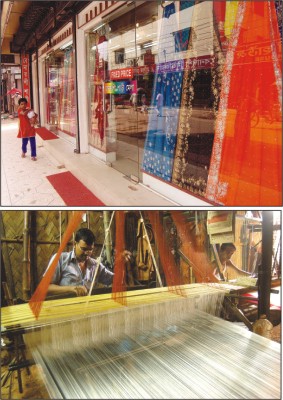 “Women don't want Katan or Benarosi anymore. They have been wearing it for years. Now they want something new,” he added.
Original weavers however differ with this statement. Mohammad Kashem, general secretary of Benarosi Palli Shop Owners Association, said that there are many women who still want Katan and Benarosi but its production has declined drastically.
Kashem's family is one of oldest in the area. His family along with many others, mostly weavers, arrived from Banaras, India during the partition in 1947. A large segment of the people who arrived here from Bihar later became the apprentice of these weavers.
“Women don't want Katan or Benarosi anymore. They have been wearing it for years. Now they want something new,” he added.
Original weavers however differ with this statement. Mohammad Kashem, general secretary of Benarosi Palli Shop Owners Association, said that there are many women who still want Katan and Benarosi but its production has declined drastically.
Kashem's family is one of oldest in the area. His family along with many others, mostly weavers, arrived from Banaras, India during the partition in 1947. A large segment of the people who arrived here from Bihar later became the apprentice of these weavers.
Currently there are around 4,000 handlooms in the Benarosi Palli. Kashem informed that only 5 years ago the number was around 25,000 spreading all the way from Mirpur section 10, 11 and 12. The rhythmic whipping of handlooms all day was the most prominent sound in the area. The noise is gradually dying away.
The sales area however is expanding every day, outside the original Benarosi Palli. There are 98 stores in the area now. Majority of them keeps the spotlight on georgette and chiffon saris with Karchupi, Jari work with sequins, bids and stones.
Kashem explained, “There are various aspects that led to the fall of this glorious tradition. The most important reason is that it is no longer cost effective. Weavers could not survive with their income so they moved on to other trade.”
“A large segment of weavers learned Jari work. Another major reasons is that the industry did not receive enough endorsement,” he said. “The only factor that is still keeping Benarosi and Mirpuri Katan alive is that various fashion houses of the city is still promoting them. They are our major customers.”
Most weavers work for 'mohajons' who later sell their products to various shops. One of the mohajon explained, expert weavers take around 5 to 7 days to produce a Katan sari. One Katan requires around Tk 580 worth of yarn while Jari for one sari costs around Tk 500.
Payment of the weavers depends on the design of the sari. It is around Tk 200 to Tk 400. A sari with intricate design takes more time to weave so it costs more. Mohajons often employ rented handlooms from other weavers. Per handloom rent is around Tk 200. In addition to this, there is house rent and electricity bill.
On the other hand, price of yarn is increasing every day. Yarn currently sells at Tk 720 per kg. Only a year ago it was around Tk 360. All these factors are making Benarosi and Katan sari less profitable.
“The profit is so meagre compared to all the excruciating labour and investment that it is no longer cost-effective,” said Mohammad Sonu, one of the weavers.
"My father was a weaver. I inherited the profession from him. But I never want my children to become what I am. It is very hard to survive as a weaver," he added.
There are also local politics involved, said one of the senior weavers on condition of anonymity. "The Benarosi Palli and production is no longer in control of the original weavers who understand the value and tradition of the product.”
Back to Content
8. 2 Glory of Jamdani glimmers amid winds of change
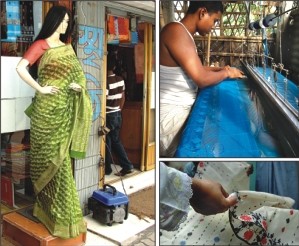 Once adored by the Sultans and Nawabs, Jamdani, the descendant of ancient fine muslin cloth, still remains the pride of Dhaka. Yet, with all its fame and glorious journey through centuries, the splendid cloth faces a few stumbling blocks that threaten its existence.
Historically, the area around Dhaka and Narayanganj has always been the hub of handlooms. The surrounding area grew the finest quality cotton, Karpash, the key ingredient for weaving Jamdani.
Once adored by the Sultans and Nawabs, Jamdani, the descendant of ancient fine muslin cloth, still remains the pride of Dhaka. Yet, with all its fame and glorious journey through centuries, the splendid cloth faces a few stumbling blocks that threaten its existence.
Historically, the area around Dhaka and Narayanganj has always been the hub of handlooms. The surrounding area grew the finest quality cotton, Karpash, the key ingredient for weaving Jamdani.
Besides, the aesthetic senses of the royal patrons helped Jamdani weavers make the embroidered fabrics with eye-catching design.
Still the villages in Rupganj, Araihazar, Sonargaon, Shiddhirganj and other places around the Shitalakhya remain the main Jamdani-making belt. Weavers in many other places in the country and in West Bengal tried to make Jamdani, but what they made were not comparable to that made by the weavers of Dhaka.
“It is the exceptional weaving technique…the embellishment of splendid loom-embroidered motifs makes Jamdani so exquisite,” said Ruby Ghuznavi, managing director, Aranya Craft Ltd, who is doing research on traditional fabrics.
“It is said that the silted waters of the Shitalakhya river gives the air a unique dampness and a perfect temperature early in the morning, giving a certain quality to the yarn. In the olden days, the artisans worked on the loom only around daybreak,” she added.
Jamdani is hand-woven in old-fashioned bamboo looms set up in a shallow trench. One specialty of Jamdani loom is that it does not make any sound while weaving. Artisans use a throw shuttle locally known as maku to weave the intricate fabric. With the choreography of a nifty hand the throw shuttle goes from one end to the other, interweaving the threads, creating and recreating the motifs with precision.
In the beginning it was produced only in whites, later with black, grey and straight golden line borders. Colours appeared in the 19th century, Ruby said.
“A very remarkable feature of Jamdani is the designs are never sketched or outlined. Jamdani designs are made while the fabric is still on the loom, inserted by hand during the process of weaving, producing the effect of embroidery,” she explained.
Another important character of Jamdani sari is the motifs, mostly floral, are of geometric shape, and the sari is embossed with the design often in a diagonal form.
Traditional variety of motifs include 'Butidaar' in which a spray of small floral patterns ornate the sari. When the floral patterns diagonally spread all over the fabric it is called 'Tercha'. Ornamentation with a network of floral motifs is called 'Jhalar or Jaal' as it spreads like a net. Then there is Phulwar and the one with large flower called the 'Toradar.' Most prized among all motifs is the 'Panna Bazar' or the 'Thousand Emeralds'.
Artisans later used names such as Corolla Buti, Dhaner Sheesh, Bansh Phool, Puna Phool, Bagher Pa, Ichadar and many more. “These motifs are basically the weavers' insight of the nature, the simple things of everyday life,” Ruby said.
“Another unique feature of the motif is that there are no human or animal figures in Jamdani. This is probably because it was always worn by Muslim royalties and woven by Muslim weavers,” she added.
Neatly cut yarn from the finest quality Karpash is the key element to weave a perfect piece of Jamdani. In the olden days only young women below the age of 18 used to cut the yarn with their soft fingers. The most appropriate time for making the yarn is early morning as the air then carried the highest moisture.
The wonder cotton Karpash is long gone. Today the weavers buy yarn from the market and use chemical dyes instead of herbal dyes. And they have also surrogated cotton with silk that completely changed the nature of Jamdani. Today the market is abundant with the gleaming version of half silk Jamdani (Shahnaz Parveen
After a glorious journey through centuries Jamdani craftsmanship is considered an endangered trait. Experts' doubt how long the glory would last as the product is losing its originality. The magic fabric exists through many modifications.
“Jamdani is losing classical patterns due to intervention of modern designers. They are experimenting with the fabric and its motifs these days changing the originality and weavers are just following orders because they have to survive,” said Shahid H Shamim, director, Prabartana, who works on Jamdani and other fabrics.
Shamim said one of the main problems with Jamdani is that it cannot be produced cheap as the intricate process of weaving requires a very long time. Price of yarn and colour is always on the rise. The high price of Jamdani discourages many consumers.
Besides, after being transformed into half-silk product, it has become very tough to maintain today's Jamdani. Half silk disintegrates easily, washing becomes difficult and at the same time use of silk makes the product even costlier.
“When you change the basics then it is no longer a Jamdani. Jamdani had always been cotton based,” Shamim said.
The main Jamdani-making belt is now threatened as the river Shitalakhya is encroached and the riverbank is congested with factories and mills. The water, which changed its course over the years for encroachment and many other reasons, is polluted. The area no longer produces the fine Karpash cotton, the wonder behind the magnificent fabric.
The survival of Jamdani artisans has become difficult with many inconveniences in their life, which is another reason why Jamdani faces the risk of extinction, Shamim said.
Although many non-government organisations, designers and fashion houses are patronising the industry, the artisans still struggle to survive. A good piece of Jamdani sari needs the sweat and labour of around two months but the weavers are often deprived of fare wages and their share of profit as they do not have direct access to market.
The marketing system is still controlled by the middlemen, who often form informal cartels. Many artisans are now switching to other occupations for better life.
Weavers no longer want their next generation to get involved in the profession that was once so proudly nurtured by their forefathers.
According to a survey by Bangladesh Small and Cottage Industries Corporation (BSCIC), now there are only around 5,500 artisans in the Jamdani villages, where once the entire community was associated with Jamdani craftsmanship.
“The most gruesome part of this industry is that the loom owners are now using child labour to curtail the cost,” Shamim pointed out. “It is posing a threat to the age-old traditional industry as these children do not belong to original Jamdani artisan family. They come from many surrounding districts,” he added.
He alleged that these children have to work as bonded labour for 10 to 12 hours a day. For them it is just another job that helps them survive.
“A child from original Jamdani makers' family on the other hand inherits the heritage and has the skill and creativity in their blood,” Shamim noted.
Back to Content
9. Manasa Mangal ritual
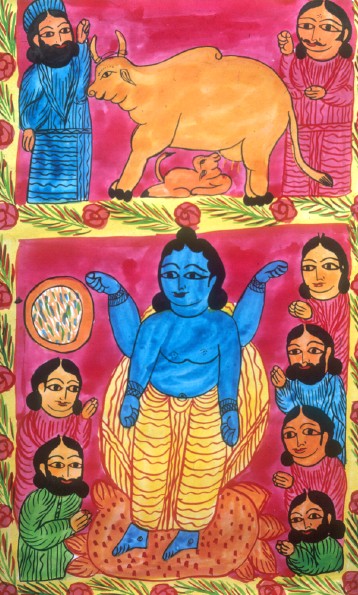 Manasa Mangal, (Bipradas Pipalai 1545 AD) a medieval Bengali classic about the serpent-goddess Manasa. These stories related to mythology are the main elemnets of the Pat-chitra culture.
Manasa Mangal, (Bipradas Pipalai 1545 AD) a medieval Bengali classic about the serpent-goddess Manasa. These stories related to mythology are the main elemnets of the Pat-chitra culture.
Patuas, like the kumars, started out in the village tradition as painters of scrolls or pats telling the popular mangal stories of the gods and goddesses. For generations these scroll painters or patuas have gone from village to village with their scrolls or pat singing stories in return for money or food. Many come from the different villages of Bengal. The pats or scrolls are made of sheets of paper of equal or different sizes which are sown together and painted with ordinary poster paints. Originally they would have been painted on cloth and used to tell religious stories such as the medieval mangal poems. Today they may be used to comment on social and political issues such as the evils of cinema or the promotion of literacy.
Mangal kavyas are auspicious poems dedicated to rural deities and appear as a distinctive feature of medieval Bengali literature. Mangals can still be heard today in rural areas of West Bengal often during the festivals of the deities they celebrate, for example Manasa puja in the rainy season during July-August when the danger of snake bite is at its peak. Interestingly, it is the mangal stories connected with this particular art form that provide us with some of the earliest clues about the worship of clay images in Bengal.
The two most famous poems in this respect are the Chandi Mangal and the Manasa Mangal. In the Chandi Mangal of the Bengali poet Mukundarama Chakravarti (16th c), known as Kavikankana, the village goddess Chandi takes on the form of the Puranic deity Mahisasuramarddini (Durga) before the startled eyes of the hunter Kalketu and his wife.
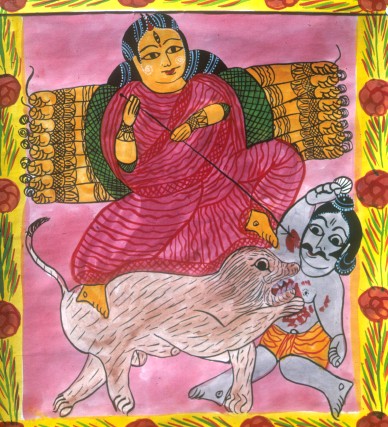 Chandika took the form of Mahisasuramarddini
In eight directions the Ashtanayikas shone forth
Chandika took the form of Mahisasuramarddini
In eight directions the Ashtanayikas shone forth
Her right foot rested on the back of a lion
Her left foot on the back of the demon Mahisha
With her left hand she held Mahisha's hair
With her right hand she placed her trident in his chest
On her left side shone her matted locks
Her headress encompassed the whole circle of the sky
Bracletes and armlets adorned her ten arms
In this form she receives puja from the whole world
A noose, a goad, bell, mace and bow
These five weapons gleam in her five left hands
A sword, discus, trident, spear and brightly-shining arrows
In her right hands gleam these weapons
To her left is Karttikeya, to her right Ganesa
Above, Shiva rides on the head of a bull
To her right is Laksmi, to the left Sarasvati
Facing her, deities sing various hymns
Her limbs outshine molten gold
The colour of her three eyes outcolours blue lotuses
And her face outshines the autumnal moon.
(Kavikankana Chandi)
What this mangal poem hints at is that the style of Durga images seen today in the clay images of Bengal was already popular in the 16th c. Durga is popularised as the beleagured wife of the farmer god Shiva. She may be the mighty awe-inspiring goddess who kills demons, but she is also the compassionate mother or Ma and the devoted daughter who returns home during the autumnal festival of Durgotsava. Throughout mangal literature, the village deities are shown as very accessible figures who communicate freely with mortals and share their griefs and delights.
Tha main part of the mangal concerns the fate of Lakhindar and his bride Behula. Manasa warns that Lakhindar will die on their wedding night. So Chando has an iron room built to keep out any snakes that might kill his only son. However, Manasa persuades the architect to leave a gap big enough for one of her deadliest snakes to squeeze through at night and bite Lakhindar as he sleeps. Behula wakes up too late to help her newly-wed husband.
In this pat the snake goddess Manasa sends a poisonous snake to kill the hero Lakhindar while his wife Behula looks on helplessly. The iron room made to protect them on their wedding night proves useless.
The distraught Behula scolds Chando for his quarrel with Manasa and returns her wedding gifts. Instead of cremating her husband's body and scattering his ashes in the river as is the Hindu custom, she sets off downriver in a desperate bid to persuade to gods to revive her husband so that she avoids the fate of being made a young widow
Manasa pat shows how Behula sets off downriver on a raft made of banana bark carrying her husband's corpse on her lap hoping to persuade the gods to revive Lakhindar. On the way she meets the fisherman Goda who taunts her but Behula replies that she worships only the mother Manasa and she floats off again downstream.
Further on, she visits the city of the gods where she meets the gods Brahma, Vishnu and Shiva who are impressed by her skills as a dancer and washerwoman to the gods. Shiva decides to persuade Manasa to revive Lakhindar and his six brothers in return for persuading Chando to worship the snake goddess.
The Snake Litanies
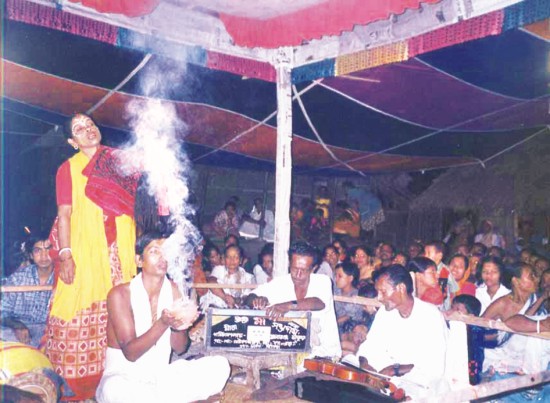 About ten kilometers to the south of Rangpur, in the village of Fatehpur the widows have a tradition of singing these songs about Manasa, or snakes. It is said that not everybody can appreciate this art. After receiving the letter from my friend Nurunnabi Shanto, I got the strong desire to go and see this performance by the widows. I was particularly excited because I had never before seen women perform this Manasa Mangal ritual. And yet, Manasa naturally seems like a woman's territory. But in the performances that I had seen before, there were no actual women. The female roles were played by men. So why were the women of Rangpur an exception? A hundred possible explanations came to my mind; I couldn't decide. I couldn't wait to visit Fatehpur village. But the first thing on my pre-set itinerary was visiting Pirojpur, Bagerhat. My Rangpur trip then, had to come later.
About ten kilometers to the south of Rangpur, in the village of Fatehpur the widows have a tradition of singing these songs about Manasa, or snakes. It is said that not everybody can appreciate this art. After receiving the letter from my friend Nurunnabi Shanto, I got the strong desire to go and see this performance by the widows. I was particularly excited because I had never before seen women perform this Manasa Mangal ritual. And yet, Manasa naturally seems like a woman's territory. But in the performances that I had seen before, there were no actual women. The female roles were played by men. So why were the women of Rangpur an exception? A hundred possible explanations came to my mind; I couldn't decide. I couldn't wait to visit Fatehpur village. But the first thing on my pre-set itinerary was visiting Pirojpur, Bagerhat. My Rangpur trip then, had to come later.
Behula
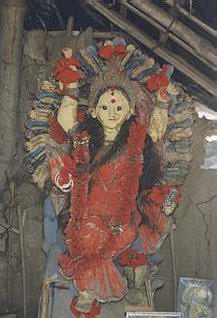 Behula is the heroine in the Bangla epic of Manasamangal. Manasamangal was written between the thirteenth and eighteenth centuries. Though its religious purpose is that to glorify the Hindu goddess of Manasa, it is more well known for depicting the love story of Behula and her husband Lakhindar. Lakhindar's father angers Manasa, who causes Lakhindar to be bitten by a snake on his wedding night, though he and Behula are enclosed in an iron made house. Behula sails alone with her husband's dead body on a boat. She finally appeases the goddess and brings Lakhindar back to life.
Behula continues to fascinate the Bengali mind, both in Bangladesh and West Bengal. She is often seen as the archetypal Bengali woman, full of love and courage. Behula is the heroine in the Bangla epic of Manasamangal. Manasamangal was written between the thirteenth and eighteenth centuries. Though its religious purpose is that to glorify the Hindu goddess of Manasa, it is more well known for depicting the love story of Behula and her husband Lakhindar. Lakhindar's father angers Manasa, who causes Lakhindar to be bitten by a snake on his wedding night, though he and Behula are enclosed in an iron made house. Behula sails alone with her husband's dead body on a boat. She finally appeases the goddess and brings Lakhindar back to life.
Behula continues to fascinate the Bengali mind, both in Bangladesh and West Bengal. She is often seen as the archetypal Bengali woman, full of love and courage.
In Hinduism, Manasa is a naga and goddess of fertility. She is popularly known as the goddess of wish fulfilment and one who protects against snakebite. She is also associated with the earth and higher knowledge. Though she is venerated mostly in eastern India.
She is probably a pre-Aryan goddess but this tale is of more recent vintage and comes from Bengal where she is most revered and tells how she gained recognition for herself as a potent member of the Hindu pantheon.
When Manasa approached Chand, he refused to worship her. This infuriated Manasa, and she killed all his sons. After this event, Chand's wife Sonika gave birth to their seventh son Lakhinder (also referred as Bala). Manasa's wrath had not been pacified even by the time when Lakhinder's marriage to Bihula was fixed.
She vowed to kill him on the Suhaag Raat (The night after wedding, when bride and groom sleep together for the first time). To counter the threat, Chand planned to construct an iron room for Lakhinder's Suhaag Raat. However, Manasa threatened the blacksmith as well, and asked him to keep a small pinhole in the room. As nobody noticed this hole, In the night, Manasa sent a very thin snake to enter the room through the pinhole. Once inside the room, this snake turned into a Cobra and bit Lakhinder, killing him instantaneously. Bihula overcame grief and built a boat to go to Heaven to present this injustice to gods. Lakhinder was then revived by the gods. During the return from Heaven, Bihula managed to persuade Chand to worship Manasa. Chanda grudgingly agreed to worship her with his left hand. To this day, Manasa is the only Hindu goddess worshipped by the left hand. In the Anga region, she is also known as Bishahari and worshipped to prevent snake-bite related deaths. The boat created by Bihula was made up of jute straws (Manjusha) and paper. This led to development of Manjusha art, which is now on verge of extinction.
|
Royani:
Royani is the music of Manasas. It is the music of Behula.” At Meeradi's words I come back to the topic of Manasa, she seemed to make perfect sense. Of course, the songs were about the two women- Manasa and Behula. Both of these women have had to overcome many obstacles to be well respected in society. Men do not understand the pain and anguish these women have had to go through.
One woman has many forms-the mother, the daughter, the sister.The whole performance was about the self-image and self-perception of these women. In that way, the show was kind of autobiographical.
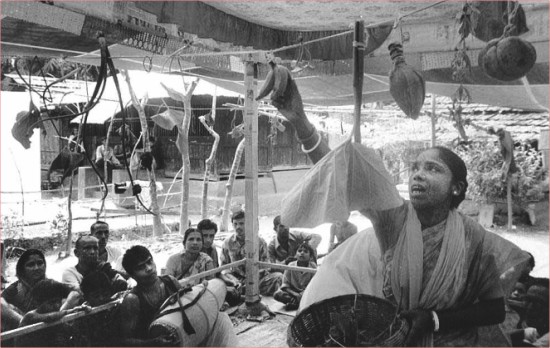 The whole performance is about singing and dancing. And throughout the performance the women of the whole village tirelessly performed the whole night, but in a manner as mundane as their lives. There were no frills. It seemed as though the show was inseparable from their lives- it was nothing special. For these women, performing is not much different from doing everyday chores like cooking. They all routinely get up to make rafts out of tree trunks as if they have done this many times before. Behula and Lakhshmindar get up on the raft and sail off. Lakhshimdar had been bitten, and bite victims must be put on a raft and sent away. Behula accompanied him as a perfectly virtuous wife. At this point in the performance, we feel the pain of Behula.
The story of Behula is well known in Bangladesh. But this performance opens ones eyes to other things. Other sociocultural aspects come through in the way the performance unfolds, that one cannot understand from just casually hearing about the story. My experience at Rangpur was unique. The evening did shed light on the lives of these women, what songs mean to them and their lives (Simon Zakaria, Daily Star, July 21, 2007).
The whole performance is about singing and dancing. And throughout the performance the women of the whole village tirelessly performed the whole night, but in a manner as mundane as their lives. There were no frills. It seemed as though the show was inseparable from their lives- it was nothing special. For these women, performing is not much different from doing everyday chores like cooking. They all routinely get up to make rafts out of tree trunks as if they have done this many times before. Behula and Lakhshmindar get up on the raft and sail off. Lakhshimdar had been bitten, and bite victims must be put on a raft and sent away. Behula accompanied him as a perfectly virtuous wife. At this point in the performance, we feel the pain of Behula.
The story of Behula is well known in Bangladesh. But this performance opens ones eyes to other things. Other sociocultural aspects come through in the way the performance unfolds, that one cannot understand from just casually hearing about the story. My experience at Rangpur was unique. The evening did shed light on the lives of these women, what songs mean to them and their lives (Simon Zakaria, Daily Star, July 21, 2007).
...The Bridal Chamber of Behula is stand in the south 2 k.m. from Mohaastan garh, Rangpur, Bangladesh.
Back to Content
10. Back to the Roots in Vegetable Dye Sari
History of Sari
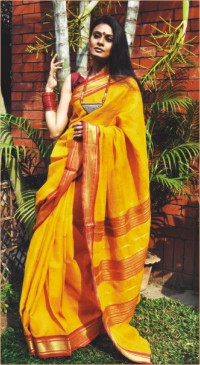 The earliest documentation of woven fabric in the Indian subcontinent is found on the sculpted bust of King-Priest of Mohenjo Daro-Indus Valley Civilization-2200-1800 B.C.The 3 sun shaped discs "Trefoil" show the unity of sun earth & water gods .This shawl pattern is still reproduced today in Sindh , Pakistan. The same trefoil was found on the Hathor cow and on the bodies of Sumerian bulls in Mesopotamia. The earliest documentation of woven fabric in the Indian subcontinent is found on the sculpted bust of King-Priest of Mohenjo Daro-Indus Valley Civilization-2200-1800 B.C.The 3 sun shaped discs "Trefoil" show the unity of sun earth & water gods .This shawl pattern is still reproduced today in Sindh , Pakistan. The same trefoil was found on the Hathor cow and on the bodies of Sumerian bulls in Mesopotamia.
Buddhist literature chronicles the work of the skilled weavers and spinners of Kashi who excelled in fine muslin, so fine that oil could not seep through. It was women who spun, and the cotton cloths were washed, calendered, starched and perfumed. Fine cotton muslin was used to wrap the bodies of emperors and also the Buddha when he attained enlightenment nirvana.
The woven cloth, textile design and iconography in early India was based on the principles of different Vedas - hence the trefoil motif of the King Priest from Mohenjodaro showing the unity of sun, earth, and water gods.
The mystique of the weaver is rooted in custom and ritual of religion. This created a relationship between him and the cloth that he wove. The cosmos, the ordered Universe, was seen as an endless and continuous fabric with its grid pattern of warp and woof over which is painted life in all its cycles, illusions and dreams.
In the olden times when weaving was done manually, the Master weaver was celebrated as an artist, a musician, and his loom an instrument of music. He memorized the patterns. The raga was established as he threw the shuttle through the tautly stretched warp threads, back and forth, over and over again. He beat the warp rhythmically, keeping taal. The wooden pedal was depressed to synchronize the throwing of the shuttles.
SOUTH Asians have had a simple answer to Cinderella's fairy godmother for a long time now, and this is the sari. It is amazing how a simple piece of cloth measuring roughly 12 yards in length and requiring no form of stitching can transform a woman into a symbol of femininity and grace. Saris have been the attire of choice for our women folk since ages ago, and are still reigning today for their ability to bring out the best in a Bengali woman. These magic outfits come in a wide range of fabrics and designs.
In a country where jamdani and silk is only for the rich but not necessarily famous, hand woven saris are the choice apparel for those on a budget. It has been in use during the English rule when all else was considered a threat to the English cloth industry. For both the weavers and the common people this type of sari became their preferred material. Taat or handloom materials have a rather heavy texture. These came in solid colours or in simple designs known as Dhakai Biti and Pabna Biti. Check and stripes were the prevalent patterns in a market that was starting to become crowded with Indian and Pakistani brands.
I am sorry I cannot hide my tears from you
If you remember me, put on your beautiful sari
and mascara on your eyes, braid your hair properly.
Jasim Uddin - The Field of the Embroidered Quilt
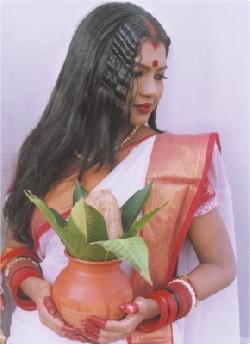 The Indian sari with its long history is one of the most ancient dresses that have been designed since ages. With its simple elegance it has is one of the most expressive clothes of woman’s femininity. Over centuries, this dress has changed in form and content. It has varied in designs and colors so that other dresses have come out of it even across the Indian borders as well as in other parts of the world of international fame. The Indian sari with its long history is one of the most ancient dresses that have been designed since ages. With its simple elegance it has is one of the most expressive clothes of woman’s femininity. Over centuries, this dress has changed in form and content. It has varied in designs and colors so that other dresses have come out of it even across the Indian borders as well as in other parts of the world of international fame.
However, the first proof that the Indian sari was worn was found with the small statues of Sumer that goes back to 2000-3000 B.C. This was the time of the Indus valley civilization. There are many references to the Sari in the premier works of Sanskrit literature. The “Rig Veda” book that goes back to 1200 B.C. tells about the golden bright Sari and perhaps about the brocade. In the heroic poem of Mahabharata, there is a reference to the pearl-embroidered Sari. Mural-paintings in Ajanta caves featured the Bandana Sari or the warp and weft weave.
Every part of the Sari expresses many things and tells pleasant and sad stories. Moreover, it shares the pleasure and sadness of a woman who wears it. It accompanies her in all different stages of her life, in marriage and motherhood as well as many other human experiences. It also represents her mood and tells about the occasion for which it is worn. The way in which it is tied tells the woman’s social class.
Since the Sari is strongly connected to people’s life and their traditions, every area of India has its own way of weaving it that explains the skills of its weavers and of those who tainted it. Bengal is known for the silk Sari that is tied in Kantha that gives a classic example of preserving Indian skillful handcraft. Making only one of these Saris takes six months. The silk Sari and the brocade clothes of Banares embody the continuity of old handcrafts.
Women from Bengal in Eastern India are strongly abided by traditions. Their life style is simple. Their festival day reflects their keenness on traditions. They tie the Sari without folds.
|
DACCAI JAMDANI
Nestling in rural Bengal, amidst lush green paddy fields, punctuated by picturesque pukurs (ponds) are entire weaver villages engaged in creating the equivalent of poetry on fabric. Triumphing over the trauma of partition, weaver families which migrated to West Bengal in the 1950’s have helped keep alive a priceless heritage of highly stylized weaving techniques honed over generations. The handloom industry in the eastern region has had its share of bumpy rides, but Bengal handlooms have survived the ups and downs to become a household name among connoisseurs of textiles.
There are at least six varieties of Bengal handlooms, each deriving its name from the village in which it originated, and each with its own distinctive style. The undisputed queen of the range, however, is the fabled Jamdani, which in all its myriad local avtars continues to retain its original grandeur and sophistication. The original version is referred to as Daccai jamdani, although it is now produced in Navdeep and Dhattigram, in West Bengal.
Daccai Jamdani is distinguished from its mutant cousins by its very fine texture resembling muslin and the elaborate and ornate workmanship. In Bangladesh, weavers use fine Egyptian cotton, while the Indian weavers use only indigenous raw material. The single warp is usually ornamented with two extra weft followed by ground weft. While the original Bangladeshi sari is almost invariably on a beige background, the Indian weavers are a little more adventurous in their choice of color schemes. The gossamer thin black Jamdani with its splash of multi colored linear or floral motifs sprinkled generously all over the body and border and crowned with an exquisitely designed elaborate pallu is a feast for the eyes.
The Daccai Jamdani is woven painstakingly by hand on the old fashioned Jala loom, and many take even up to one year to weave a single sari. It feels supple to the touch and drapes gently to reveal the contours of the wearer.
 Historians cannot exactly determine when jamdani came about but it is well known that the descendants of the muslin weavers kept this trade alive. Jamdani also needs climatic conditions for proper development. It also requires a humid environment and that is why many weavers set up their business alongside riverbanks. Its creation is different from other fabrics in the sense that it does not use needles or the jacquard process. The craftsmen use tiny wooden or bamboo spikes to draw the intricate designs that consist of geometrical shapes.
Historians cannot exactly determine when jamdani came about but it is well known that the descendants of the muslin weavers kept this trade alive. Jamdani also needs climatic conditions for proper development. It also requires a humid environment and that is why many weavers set up their business alongside riverbanks. Its creation is different from other fabrics in the sense that it does not use needles or the jacquard process. The craftsmen use tiny wooden or bamboo spikes to draw the intricate designs that consist of geometrical shapes.
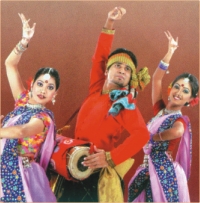 Taking a look at Bailey Road, one finds that during the past few years, it has developed into a popular 'shoppers stop' for deshi saris and other handloom products. Among the attractions is the shop of Munira Emdad, popularly known as the "Didi moni" of the Tangail sari market. She is one of the women pioneers of our country who has invested years into promoting the deshi sari industry.
With limited capital of US Dollars 1,000, Munira gathered some weavers and set up a single roomed outlet at Baily road in 1982. 'It was sometime after liberation, I noticed,' went on Munira, 'the weavers of Tangail and Pabna designed and sold saris at the market. These saris were coarse and inadequate in length. Naturally it failed to attract the ladies with finer taste.
Taking a look at Bailey Road, one finds that during the past few years, it has developed into a popular 'shoppers stop' for deshi saris and other handloom products. Among the attractions is the shop of Munira Emdad, popularly known as the "Didi moni" of the Tangail sari market. She is one of the women pioneers of our country who has invested years into promoting the deshi sari industry.
With limited capital of US Dollars 1,000, Munira gathered some weavers and set up a single roomed outlet at Baily road in 1982. 'It was sometime after liberation, I noticed,' went on Munira, 'the weavers of Tangail and Pabna designed and sold saris at the market. These saris were coarse and inadequate in length. Naturally it failed to attract the ladies with finer taste.
Sari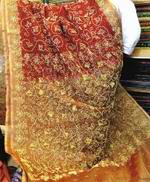 The sari has always had a distinctive appeal in fashion and has blended in well with the Bangalee culture and heritage.
Some saris designs are evergreen and have a timeless appeal. There are saris for every occasion: ranging from weddings to festivals. The shining colour of Benarasi, its impeccable design, embroidery of golden and silver yarn- all these have rendered Benarasi a unique place at all times.
There are varieties of Benarasi sari like Ranguly Katan, Satin Brocade Katan, Ahamori Katan, Shundari Katan, cascade Katan, Muslin Katan. The price of a Benarasi Sari depends on its immaculate design and gravity. The sari has always had a distinctive appeal in fashion and has blended in well with the Bangalee culture and heritage.
Some saris designs are evergreen and have a timeless appeal. There are saris for every occasion: ranging from weddings to festivals. The shining colour of Benarasi, its impeccable design, embroidery of golden and silver yarn- all these have rendered Benarasi a unique place at all times.
There are varieties of Benarasi sari like Ranguly Katan, Satin Brocade Katan, Ahamori Katan, Shundari Katan, cascade Katan, Muslin Katan. The price of a Benarasi Sari depends on its immaculate design and gravity.
SARI is a quintessential Bangladeshi female garment. There is possibly nothing that identifies a woman as being Bangladeshi so strongly as does the sari. It comes in more or less a single size but the weaves, textures, print, embellishment and composition vary and there is a wide multiplicity of traditional saris that exist in Bangladesh.
In Bangladesh, terra cotta art from the Gupta period (50 BC- AD 300), depicts a woman wearing a full-skirted sari draped around her entire body.
The Benarasi saris require meticulous craftsmanship. The karigars (craftsmen), who compose the main design and their associates (commonly known as the helpers) put in considerable effort to give the customers the exquisite finished product. The artistry of Benarasi lies particularly in its design. However, there is no certain formula for the exclusive designs. The karigar uses his artistic skills and imagination to give the sari a final touch.
Although Benarasi saris hailed from India's ancient city Benaras, shopkeepers say that Dhakai Benarasi has gone past its predecessor in its quality. Dhakai Benarasi is woven from thread and golden-silver yarn imported from China, Japan and Pakistan and is claimed to be of superior quality in terms of its brightness and longevity. A large area at Mirpur's block eleven is occupied by the 'Benarasi Palli'. Several factories are located here. A view of Mirpur Benarasi Palli reveals small cottage industries operating from narrow tin sheds.
In Bangladesh there are mainly three different kinds of woven saris, Pabna, Dhakai and Tangail, each having its strong characteristics that is clear and unmistakably unique.
Cotton jacquard border:
These are pure cotton weaves and the ground is sometimes plain solid in a single colour but it is observed that the interest lies in developing grounds with various assimilation of warp and weft yarns. This easily creates formation of checks and stripes. Implementing three or more colours can be rather interesting as the designs can reflect complex structure in weave. The model is wearing one such sari with an exceptional composition.
Tangail baluchar:
These are Tangail's take on the baluchari sari's that are traditionally woven in the Burdwan district state of Bengal in India. This is a time honored weave. In its truest form these saris demonstrate integrated designs that reflect mythical stories in the end piece and borders. Figurative designs are almost like a repetitive tapestry in a more engineered form.
In Bangladesh however baluchori's usually display fantasy floral, paisleys, and geometric patterns woven in high quality mercerised cotton yarns. You will find the model dawning an ivory and red sari with a stunning end piece
Tangail jamdani:
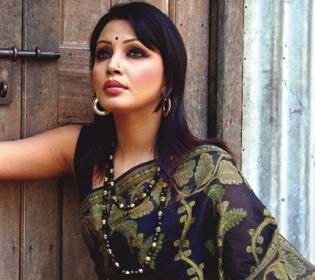 This is a kind of Tangail weave, which is developed with the essence of Dhakai jamdani. Although the name suggests having some elemental similarity it is indeed no way parallel to the Dhakai's of Bangladesh. There is only a likeness in design composition. For example it may have a similar diagonal pattern on the ground or suggest a lattice motif structured similar to a jamdani but the foundation of weaving are developed with a contrary vocabulary of technique. The model is displaying one such distinct Tangail sari in Boishakhi colours. This is a kind of Tangail weave, which is developed with the essence of Dhakai jamdani. Although the name suggests having some elemental similarity it is indeed no way parallel to the Dhakai's of Bangladesh. There is only a likeness in design composition. For example it may have a similar diagonal pattern on the ground or suggest a lattice motif structured similar to a jamdani but the foundation of weaving are developed with a contrary vocabulary of technique. The model is displaying one such distinct Tangail sari in Boishakhi colours.
Jacquard Tangail:
The entire piece is developed using jacquard instrumental addition to the loom. The beginning middle and the end of the sari reflect the aesthetics of the tanchoi banaras sari. The black sari worn by the model is greatly influenced by European Art Deco pattern.
I share this from previous studies where it is clearly examined that in the late 1890's master weavers from Banaras visited England and returned with wallpaper sample books later incorporating such designs in traditional weaves. Reminiscent of damask style wallpapers, these designs still play an influential role in sari designs today.
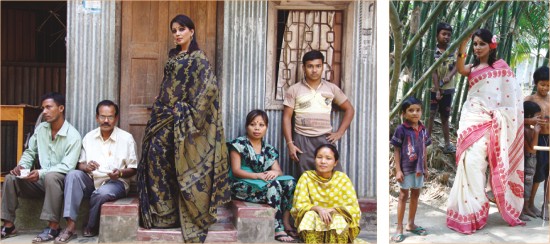
Trailblazer sari style:
In recent times some top European designers developed their entire collection based on the concept of the sari. It was indeed a tribute to the legacy of mystery that is known as the sari.
( Maheen Khan, March 31, 2009),
Aranya celebrates Boishakh
ARANYA'S marvellous collection of natural dyes have been used to highlight the colours of this season, welcoming Boishakh in a festive blaze of reds and yellows that both complement and contrast with the more soothing reds and whites on display.
Not to mention their signature blues, teals and greens, painstakingly developed from precious indigo. The classic earth tones are also available for those discerning individuals who prefer to make subtlety their hallmark.
The collection has been priced with care to meet a whole range of budgets.
Check out Aranya this Boishakh to experience a look that is distinctive and exciting (1. 04. 09)
|
'It was a time when skilled artisans were thinking of shifting from their age-old profession due to falling demand. I decided to gather a handful of weavers and provide them with new ideas and latest designs.'
Munira extended her help to buy yarns and materials for better designed saris.
Within the last 22 years, the one room store has grown into a multi-storied show room with 50 employees at four branches in Dhaka. A proud owner of Tangail
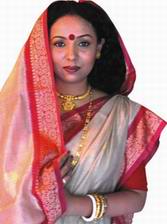 Saree Kutir, she has become an icon in the field of local saris.
Saree Kutir, she has become an icon in the field of local saris.
She has been recreating original designs in cotton saris and other local materials. More than 2,000 weavers and 500 women are directly working under her and engaged in hand embroidery, block prints and other associated work.
'New dimensions have been re-created in embroidered Tangail silk sari with karchub work for the fashion frenzied. The Mirpur Katans, Benarasi, silks and pure cotton saris are also available in a wide range of colours and shades. The Muslin, the craft silk in tie-dye, the chand-tara designs in kataan, bring back the feeling of the bygone days. The 'Shwarnalata' design was collected from a sari about 150 years old' said Munira.
With proper guidance, direction in motifs, latest trends in design and materials Tangail saris are now in full bloom in various shades and designs, capturing the hearts of the picky customers. Munira Emdad has gained wide recognition as a successful entrepreneur. Her contribution to our culture has been immense and no doubt a model for other entrepreneurs (S. Afreen Mallick, November 2, 2004) .
Manipuri Tribal Sari
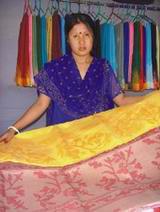 In the run up to Eid, the city is dotted with many indigenous handloom fairs. In a handloom fair in Karwan Bazar, Manipuri Handicrafts offers buyers a range of apparel. Particularly attractive to buyers are the Manipuri sarees. Ranjita Singha, the proprietor of the shop, came all the way from Maulvi Bazar along with her weavers for the fair.
She said, 'I have been in this profession since 1994. We offer buyers special designs in saris, as for instance, our exquisite Rani Sari range. The sari has been designed by a Manipuri designer Rani, who lived in Sylhet around 100 years ago. The design has been passed on among the Manipuris through generations.'
In the run up to Eid, the city is dotted with many indigenous handloom fairs. In a handloom fair in Karwan Bazar, Manipuri Handicrafts offers buyers a range of apparel. Particularly attractive to buyers are the Manipuri sarees. Ranjita Singha, the proprietor of the shop, came all the way from Maulvi Bazar along with her weavers for the fair.
She said, 'I have been in this profession since 1994. We offer buyers special designs in saris, as for instance, our exquisite Rani Sari range. The sari has been designed by a Manipuri designer Rani, who lived in Sylhet around 100 years ago. The design has been passed on among the Manipuris through generations.'
Ranjita Singha draws attention to the fact that every Manipuri family has at least one weaving machine at home to make handloom saris, salwar-kamiz, three pieces, fatua, bed cover, Jali Chadars, Orna, Shawls and the traditional costume of Manipuri girls, Filop-Fanik-Blouse (Novera Deepita, Daily Star, November 11, 2004).
Natural Indigo (Indigoferra tinctoria) and the Fight for Freedom
Back to Content
Simple sari prevents cholera
Cholera, which is caused by the bacterium Vibrio cholerae, kills tens of thousands of people around the world each year and is often transmitted via contaminated drinking water.
"It's been long known that if you can control the quality of drinking water, you can eliminate epidemics," says Steven Blanke, associate professor of biology and biochemistry at the University of Houston.
Rita Colwell, the lead author of the study and a professor of microbiology and molecular biology at the University of Maryland, discovered years ago that water plankton harbour the bacterium.
In fact, in Bangladesh, where this study took place, the September-to-October plankton bloom is followed by cholera outbreaks.
"It is naturally occurring, so it occurred to us as we did these studies that we could help people in Bangladesh - where I've done work for 25 years - [and] that simply filtering out copepods [tiny, shrimp-like structures which are a type of plankton] should reduce cholera," says Colwell, who is also head of the National Science Foundation.Because the copepod is 200 to 500 times larger than the bacterium, it is much more easily filtered, Blanke says.
As effective as designer filters
Villagers in Bangladesh commonly use untreated water from ponds and rivers for drinking and other purposes. "The most straightforward way to get rid of the bacteria is boiling, but that is not always possible," Blanke says. Often fuel, especially firewood, is in short supply.
An electron microscope told the researchers that a sari cloth, folded four to eight times, could remove all zooplankton and most phytoplankton and the cholera-causing bacterium.
The researchers then set out to test the method in the field, namely in 65 villages in rural Bangladesh, representing a population of about 133 000. When the cloth was folded at least four times, the results were astounding: cholera was reduced by about half the historical average. When people did still get sick, the severity seemed to be less.
"It was enormously successful and it can be implemented particularly in areas where you don't have enough fuel for boiling," Colwell says. "The method of choice is to boil water, but often they don't have the fuel. Women collect cow dung and dry it to use as fuel to cook meals."
he filtration process had another unforeseen benefit: Mothers reported that their children had less diarrhoea.
In addition to being cheap and convenient, using an old sari or other type of cloth has the advantage of being easily adopted by villagers.
Colwell says that when she first proposed this study, one of the reviewers expressed concern that men might not drink water that was filtered through women's clothing. In fact, the research team discovered that women had already been filtering water through folded cloth to remove flies and other visible detritus.
"This offers a potentially simple and inexpensive solution to a global problem," Blanke says. "It also showed, in part, that not only with cholera but perhaps with other diseases, solutions can be offered from understanding the basic ecology, the source of the disease and mechanisms of disease transmission", (Health 24, Tuesday, February 03, 2004).
10. Articles
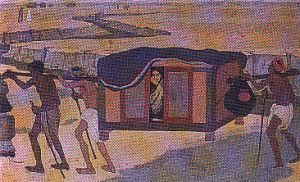
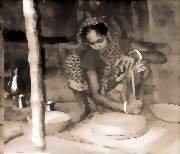

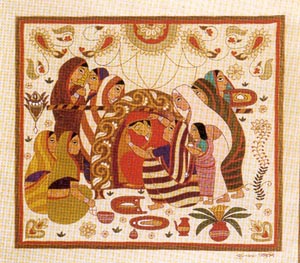
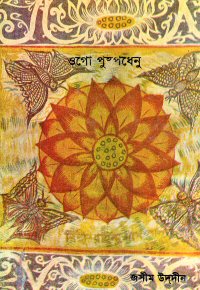
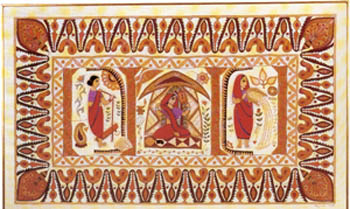
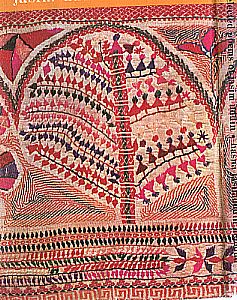
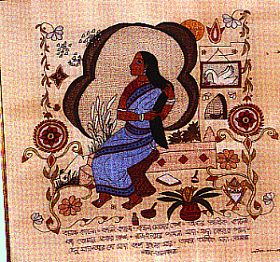
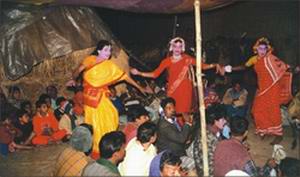
 It's impossible to deny the fact that terracotta jewellery appears fashionable and looks just fantastic if you properly pair them with the right kinds of cotton saris.
If you are an avid fan of terra-cotta jewellery then it's time you took a look at the eye catching ornaments designed and crafted by Wahida Islam (Kakoli). It's been over 4 years that this housewife has been making jewellery from clay. She has participated in numerous fairs held by MIDAS, RAOWA Club, Officers' Club (Baily Road), SAARC Trade Fair etc and won praises of many.
It's impossible to deny the fact that terracotta jewellery appears fashionable and looks just fantastic if you properly pair them with the right kinds of cotton saris.
If you are an avid fan of terra-cotta jewellery then it's time you took a look at the eye catching ornaments designed and crafted by Wahida Islam (Kakoli). It's been over 4 years that this housewife has been making jewellery from clay. She has participated in numerous fairs held by MIDAS, RAOWA Club, Officers' Club (Baily Road), SAARC Trade Fair etc and won praises of many. 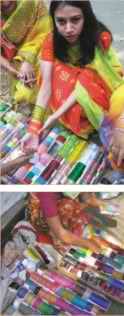
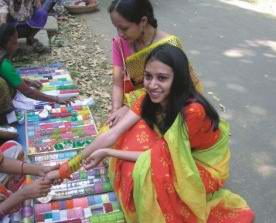
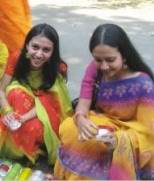
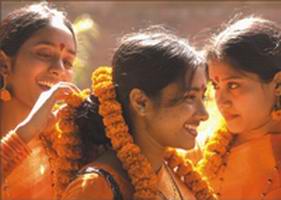
 "O Babu, many salams to you
"O Babu, many salams to you  Glass bangles may have fascinated women in the past with their colours. But their colours or styles had never been so complex and fascinating like the ones available in the market now. And the market is booming.
Even a decade ago, glass bangles came in bland colours of green, black, red and yellow. The exotic ones were either imported from India or Pakistan. But now the country's Banglee artists themselves make complex ones with dazzling strokes of hues-- gold or silver and multicoloured patterns.
Local glass bangles are produced in various factories in Gazipur, Nawabganj, Lalbagh and Azimpur. The wholesalers sell these in a number of shops opposite a mosque in Chawkbazaar in addition to imported bangles from Pakistan and India.
Glass bangles may have fascinated women in the past with their colours. But their colours or styles had never been so complex and fascinating like the ones available in the market now. And the market is booming.
Even a decade ago, glass bangles came in bland colours of green, black, red and yellow. The exotic ones were either imported from India or Pakistan. But now the country's Banglee artists themselves make complex ones with dazzling strokes of hues-- gold or silver and multicoloured patterns.
Local glass bangles are produced in various factories in Gazipur, Nawabganj, Lalbagh and Azimpur. The wholesalers sell these in a number of shops opposite a mosque in Chawkbazaar in addition to imported bangles from Pakistan and India.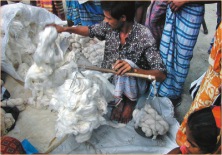
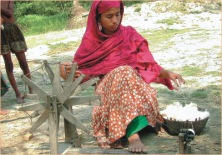
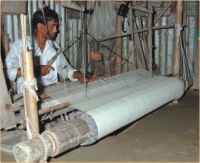
 In 1921-22 Mahatma Gandhi and his followers were on a mission for peace and patriotism. Their approach was simple, as was their choice of attire. They embraced the rough textures of the spun cotton material known as khadi.
In 1921-22 Mahatma Gandhi and his followers were on a mission for peace and patriotism. Their approach was simple, as was their choice of attire. They embraced the rough textures of the spun cotton material known as khadi. Those who are involved with khadi are also facing many difficulties. Arun Guho, the country's primary khadi producer, explained that proper cash inflow is needed to keep the industry on a winning streak. Many times items are delivered on credit. Also the cotton required for production is often unavailable according to demand. As a result the workers have to make do with whatever is available. A continuous twelve-month work period cannot be maintained. Thread made with pit loom and power loom does not provide a good finish. Producers of khadi spend about eight months using thread from textile mills and the other four months using cotton threads. Despite the fact that some other producers are doing well using foreign yarn Arun Guho wants to stick to using local material.
Those who are involved with khadi are also facing many difficulties. Arun Guho, the country's primary khadi producer, explained that proper cash inflow is needed to keep the industry on a winning streak. Many times items are delivered on credit. Also the cotton required for production is often unavailable according to demand. As a result the workers have to make do with whatever is available. A continuous twelve-month work period cannot be maintained. Thread made with pit loom and power loom does not provide a good finish. Producers of khadi spend about eight months using thread from textile mills and the other four months using cotton threads. Despite the fact that some other producers are doing well using foreign yarn Arun Guho wants to stick to using local material.  Comilla has been playing an influential role in creating woven crafts since the days of the Mughals. There were numerous weavers in the Tripura state during the 17th century. The 1890 Tripura Gazetteer tells us that a woven craft existed in the area which employed thirteen thousand men and two thousand women weavers.
Comilla has been playing an influential role in creating woven crafts since the days of the Mughals. There were numerous weavers in the Tripura state during the 17th century. The 1890 Tripura Gazetteer tells us that a woven craft existed in the area which employed thirteen thousand men and two thousand women weavers. Comilla has been playing an influential role in creating woven crafts since the days of the Mughals. There were numerous weavers in the Tripura state during the 17th century. The 1890 Tripura Gazetteer tells us that a woven craft existed in the area which employed thirteen thousand men and two thousand women weavers. Among them most were Hindu in religion and came from Mainamoti, Chandina, Gauripur, Nobinagar, Kalikachha, Dhamti and Borkamta. In Mainamoti were made brightly coloured lungies in check design as well as sarees and gamchhas. These cost between taka two and five in the currency of that time. The weavers from Shorail, Kalikachha and Nabinagar used to make very good quality dhuties and bed sheets. These used to cost from taka two to five a pair depending on their quality. Woven craft was mainly concentrated within the areas of Moenamoti, Muradnagar, Gauripur and Chandina. These weavers who had been practising this craft for generations were apt in this field long before the craft became famous in Europe. Even when the demand for material imported from London and Manchester was high, the demand for material woven within the country remained unaffected. Apparels of modern design were made from the posh imported material whereas the everyday clothing of the people of the country, such as dhuties for Hindus and lungies for Muslims, were made from our own material.
Comilla has been playing an influential role in creating woven crafts since the days of the Mughals. There were numerous weavers in the Tripura state during the 17th century. The 1890 Tripura Gazetteer tells us that a woven craft existed in the area which employed thirteen thousand men and two thousand women weavers. Among them most were Hindu in religion and came from Mainamoti, Chandina, Gauripur, Nobinagar, Kalikachha, Dhamti and Borkamta. In Mainamoti were made brightly coloured lungies in check design as well as sarees and gamchhas. These cost between taka two and five in the currency of that time. The weavers from Shorail, Kalikachha and Nabinagar used to make very good quality dhuties and bed sheets. These used to cost from taka two to five a pair depending on their quality. Woven craft was mainly concentrated within the areas of Moenamoti, Muradnagar, Gauripur and Chandina. These weavers who had been practising this craft for generations were apt in this field long before the craft became famous in Europe. Even when the demand for material imported from London and Manchester was high, the demand for material woven within the country remained unaffected. Apparels of modern design were made from the posh imported material whereas the everyday clothing of the people of the country, such as dhuties for Hindus and lungies for Muslims, were made from our own material.
 Apart from Comilla's legendary woven art, the khadi work of this area is of a quality good enough to compete with any type of cloth from any part of the world. Mahatma Gandhi's exemplary principles and protests against foreign cloth inspired the initiation of Khadi work in Comilla. A branch of the Nikhil Bharat Tantubai Samiti was founded in Comilla which helped promote the exceptional products of the Khadi industry in Kolkata, Mumbai and Chennai.
After the partition of India in 1947, Khadi work was almost on its way to extinction due to various changes in the political and social environments. Comilla also suffered the effects of those changes.
Apart from Comilla's legendary woven art, the khadi work of this area is of a quality good enough to compete with any type of cloth from any part of the world. Mahatma Gandhi's exemplary principles and protests against foreign cloth inspired the initiation of Khadi work in Comilla. A branch of the Nikhil Bharat Tantubai Samiti was founded in Comilla which helped promote the exceptional products of the Khadi industry in Kolkata, Mumbai and Chennai.
After the partition of India in 1947, Khadi work was almost on its way to extinction due to various changes in the political and social environments. Comilla also suffered the effects of those changes.
 After the liberation of Bangladesh, Khaddar work again flourished and made a name both at home and abroad, making its home district Comilla wellknown and famous all over. The weavers of Comilla have kept up with the changes in design with time, and they now follow the modern designs of Madras and Bombay Corporationss to keep their work up-to-date and suitable for the current styles of clothing. This has brought a touch of modernity to the ageold khaddar art of Comilla. A few names that must be mentioned when speaking of Khaddar art of this region are Prabodh Das, Taruni Mohan Raha, Dinesh Babu, Manmohan Dutta, Shantosh Dutta, Samar Majumdar, Swapan Majumdar, Bahar Mia, Jairam Shaha, and Shankar Babu. These persons have been related to the Khadi industry by family tradition and they have relentlessly worked to keep this art alive and vibrant.
After the liberation of Bangladesh, Khaddar work again flourished and made a name both at home and abroad, making its home district Comilla wellknown and famous all over. The weavers of Comilla have kept up with the changes in design with time, and they now follow the modern designs of Madras and Bombay Corporationss to keep their work up-to-date and suitable for the current styles of clothing. This has brought a touch of modernity to the ageold khaddar art of Comilla. A few names that must be mentioned when speaking of Khaddar art of this region are Prabodh Das, Taruni Mohan Raha, Dinesh Babu, Manmohan Dutta, Shantosh Dutta, Samar Majumdar, Swapan Majumdar, Bahar Mia, Jairam Shaha, and Shankar Babu. These persons have been related to the Khadi industry by family tradition and they have relentlessly worked to keep this art alive and vibrant.
 The poor weavers said they do not have capital to repair the flood-damaged handlooms and buy yarn and other raw materials. Most of then said they ate up the capital for survival during the recent deluge for a month and a half.
The floods silenced about 50,000 weaving factories in Kalihati, Delduar, Ghatail, Nagorpur and Madhupur upazilas as most areas there were inundated. Kalihati and Delduar upazilas were the worst affected.
The poor weavers said they do not have capital to repair the flood-damaged handlooms and buy yarn and other raw materials. Most of then said they ate up the capital for survival during the recent deluge for a month and a half.
The floods silenced about 50,000 weaving factories in Kalihati, Delduar, Ghatail, Nagorpur and Madhupur upazilas as most areas there were inundated. Kalihati and Delduar upazilas were the worst affected. 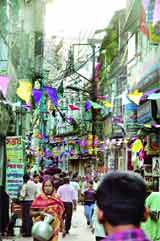
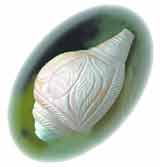
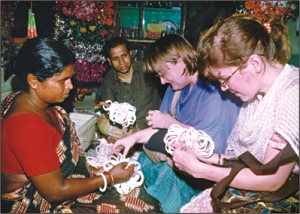
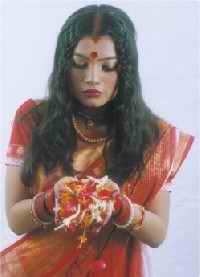
 Shanku is the divine Counch or sea shell, which is one of the insignia in the Hindu God Vishnu's hands. Lord Vishnu, also called Narayan, is imagined to have four hands. He has a Shankha (a conch shell) on one hand, the Sudarshan in second, Gada (a mace) in third and Padma (lotus flower) in the fourth.
Lord Vishnu is imagined to hold the Shanku on his upper left hand. The Shanku is used to alarm enemies and to start off war. It also represents awakening. The sound emitted from Shanku when blown, is too divine, that is used for regular rituals for Vishnu. Shanku also represents the Insignia of Vishnu. As a result of this, Shanku stands as a Royal State Emblem of Travancore and current state emblem of Kerala.
Shanku is the divine Counch or sea shell, which is one of the insignia in the Hindu God Vishnu's hands. Lord Vishnu, also called Narayan, is imagined to have four hands. He has a Shankha (a conch shell) on one hand, the Sudarshan in second, Gada (a mace) in third and Padma (lotus flower) in the fourth.
Lord Vishnu is imagined to hold the Shanku on his upper left hand. The Shanku is used to alarm enemies and to start off war. It also represents awakening. The sound emitted from Shanku when blown, is too divine, that is used for regular rituals for Vishnu. Shanku also represents the Insignia of Vishnu. As a result of this, Shanku stands as a Royal State Emblem of Travancore and current state emblem of Kerala.
 In Sitarampur Rishipur village district Jessorem a family is making bul bul netz and found market all over the world. Bul Bul birds are very popular in Bangladesh, which make most ornamented netz in palm trees.
In Sitarampur Rishipur village district Jessorem a family is making bul bul netz and found market all over the world. Bul Bul birds are very popular in Bangladesh, which make most ornamented netz in palm trees.  Birds like weaver-bird (Babui) and tailor-bird(Tuntuni) themselves are very big artists. Weaver Bird (babuipakhi) sparrowlike birds of the family Passeridae, order Passeriformes. The bird is known from its elaborately interwoven nests and locally familiar as babui or baoi. The males are often conspicuously coloured. Most species of this group of birds live in Africa, a few in Asia and Australia. Weavers are so called because their nests are made from leaf fibres woven together like a basket. The hanging nests have complex entrance tunnels. There are about 117 species of weavers worldwide; Bangladesh has three species.
Black-breasted Weaver (Ploceus benghalensis): in breeding season males have brilliant golden-yellow crown, white throat and a black band separating it from the fulvous-white underparts. In non-breeding male and female, crown brown like rest of upper plumage; black pectoral band less developed. A prominent supercilium, a spot behing ear, and narrow moustachial streaks, pale yellow. Found in flocks.
Streaked Weaver (Ploceus manyar): breast fulvous, boldly streaked with black in both sexes and at all seasons. Crown of head in breeding males yellow; in females and non-breeding males brown. Flocks are found in swampy tall reed-beds.
Baya Weaver (Ploceus philippinus): male and female in non-breeding plumage: dark-streaked fulvous brown above, plain whitish fulvous below. Bill stout conical; tail short square-cut. Breeding male has bright yellow crown and upper parts dark brown streaked with yellow. Yellow breast, cream buff on underparts. Flocks are found in open cultivation.
Birds like weaver-bird (Babui) and tailor-bird(Tuntuni) themselves are very big artists. Weaver Bird (babuipakhi) sparrowlike birds of the family Passeridae, order Passeriformes. The bird is known from its elaborately interwoven nests and locally familiar as babui or baoi. The males are often conspicuously coloured. Most species of this group of birds live in Africa, a few in Asia and Australia. Weavers are so called because their nests are made from leaf fibres woven together like a basket. The hanging nests have complex entrance tunnels. There are about 117 species of weavers worldwide; Bangladesh has three species.
Black-breasted Weaver (Ploceus benghalensis): in breeding season males have brilliant golden-yellow crown, white throat and a black band separating it from the fulvous-white underparts. In non-breeding male and female, crown brown like rest of upper plumage; black pectoral band less developed. A prominent supercilium, a spot behing ear, and narrow moustachial streaks, pale yellow. Found in flocks.
Streaked Weaver (Ploceus manyar): breast fulvous, boldly streaked with black in both sexes and at all seasons. Crown of head in breeding males yellow; in females and non-breeding males brown. Flocks are found in swampy tall reed-beds.
Baya Weaver (Ploceus philippinus): male and female in non-breeding plumage: dark-streaked fulvous brown above, plain whitish fulvous below. Bill stout conical; tail short square-cut. Breeding male has bright yellow crown and upper parts dark brown streaked with yellow. Yellow breast, cream buff on underparts. Flocks are found in open cultivation.
 Soon the two birds were caught in the nets, but this time the king would not wait for his wise men to judge them. He took a glass and swallowed tuntuna and tuntuni.
Soon the two birds were caught in the nets, but this time the king would not wait for his wise men to judge them. He took a glass and swallowed tuntuna and tuntuni. "I'll fly to you like a bird !" thousands of years the love and passion for birds rooted in the society. but since independence plenty of arms are scattered all over the country. I was shocked to see how a few rural people kill bird just for fun or picnic. Many rich from the cities visits wetlands of Bangladesh during winter months well equipped with modern weapons just to kill migratory birds for their kitchen pots. The most shocking event is that when I saw school age children killing birds. They prepare small fishes treated with a poisonous pesticde locally named "Furan" (Carbonfuran is a banned pesticide) and lay near water bodies. When the bird eats the fish immediately die. A young boy was narrating me excitedly, how he collected 50 birds. This is painful at the same time disgusting. Where are the values of our life? Most people does not listen poetries, songs, folk tales that communicated values of our life since thousands of years but have enough time to watch or listen imported films, songs and the culture of the elite of the society through TV , radio from morning to dawn.
"I'll fly to you like a bird !" thousands of years the love and passion for birds rooted in the society. but since independence plenty of arms are scattered all over the country. I was shocked to see how a few rural people kill bird just for fun or picnic. Many rich from the cities visits wetlands of Bangladesh during winter months well equipped with modern weapons just to kill migratory birds for their kitchen pots. The most shocking event is that when I saw school age children killing birds. They prepare small fishes treated with a poisonous pesticde locally named "Furan" (Carbonfuran is a banned pesticide) and lay near water bodies. When the bird eats the fish immediately die. A young boy was narrating me excitedly, how he collected 50 birds. This is painful at the same time disgusting. Where are the values of our life? Most people does not listen poetries, songs, folk tales that communicated values of our life since thousands of years but have enough time to watch or listen imported films, songs and the culture of the elite of the society through TV , radio from morning to dawn.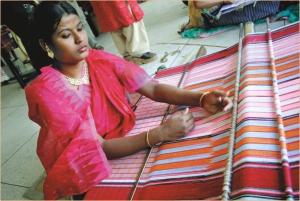
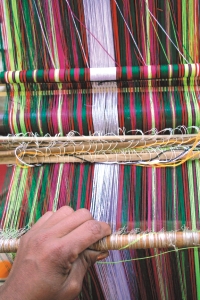
 “Women don't want Katan or Benarosi anymore. They have been wearing it for years. Now they want something new,” he added.
Original weavers however differ with this statement. Mohammad Kashem, general secretary of Benarosi Palli Shop Owners Association, said that there are many women who still want Katan and Benarosi but its production has declined drastically.
Kashem's family is one of oldest in the area. His family along with many others, mostly weavers, arrived from Banaras, India during the partition in 1947. A large segment of the people who arrived here from Bihar later became the apprentice of these weavers.
“Women don't want Katan or Benarosi anymore. They have been wearing it for years. Now they want something new,” he added.
Original weavers however differ with this statement. Mohammad Kashem, general secretary of Benarosi Palli Shop Owners Association, said that there are many women who still want Katan and Benarosi but its production has declined drastically.
Kashem's family is one of oldest in the area. His family along with many others, mostly weavers, arrived from Banaras, India during the partition in 1947. A large segment of the people who arrived here from Bihar later became the apprentice of these weavers.
 Once adored by the Sultans and Nawabs, Jamdani, the descendant of ancient fine muslin cloth, still remains the pride of Dhaka. Yet, with all its fame and glorious journey through centuries, the splendid cloth faces a few stumbling blocks that threaten its existence.
Historically, the area around Dhaka and Narayanganj has always been the hub of handlooms. The surrounding area grew the finest quality cotton, Karpash, the key ingredient for weaving Jamdani.
Once adored by the Sultans and Nawabs, Jamdani, the descendant of ancient fine muslin cloth, still remains the pride of Dhaka. Yet, with all its fame and glorious journey through centuries, the splendid cloth faces a few stumbling blocks that threaten its existence.
Historically, the area around Dhaka and Narayanganj has always been the hub of handlooms. The surrounding area grew the finest quality cotton, Karpash, the key ingredient for weaving Jamdani.
 Manasa Mangal, (Bipradas Pipalai 1545 AD) a medieval Bengali classic about the serpent-goddess Manasa. These stories related to mythology are the main elemnets of the Pat-chitra culture.
Manasa Mangal, (Bipradas Pipalai 1545 AD) a medieval Bengali classic about the serpent-goddess Manasa. These stories related to mythology are the main elemnets of the Pat-chitra culture. Chandika took the form of Mahisasuramarddini
In eight directions the Ashtanayikas shone forth
Chandika took the form of Mahisasuramarddini
In eight directions the Ashtanayikas shone forth 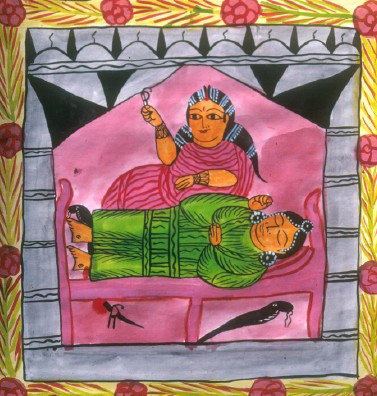
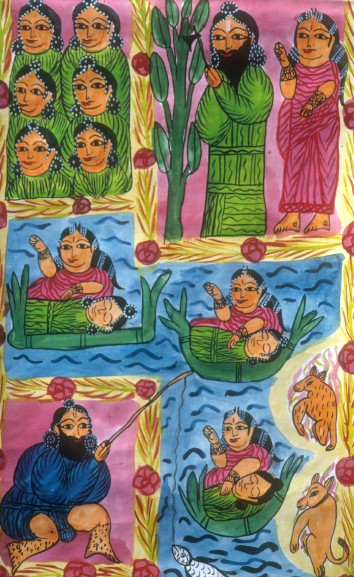
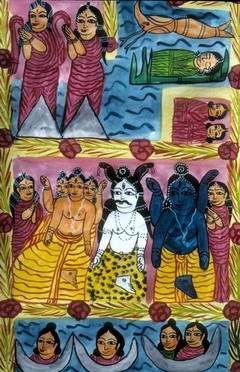
 About ten kilometers to the south of Rangpur, in the village of Fatehpur the widows have a tradition of singing these songs about Manasa, or snakes. It is said that not everybody can appreciate this art. After receiving the letter from my friend Nurunnabi Shanto, I got the strong desire to go and see this performance by the widows. I was particularly excited because I had never before seen women perform this Manasa Mangal ritual. And yet, Manasa naturally seems like a woman's territory. But in the performances that I had seen before, there were no actual women. The female roles were played by men. So why were the women of Rangpur an exception? A hundred possible explanations came to my mind; I couldn't decide. I couldn't wait to visit Fatehpur village. But the first thing on my pre-set itinerary was visiting Pirojpur, Bagerhat. My Rangpur trip then, had to come later.
About ten kilometers to the south of Rangpur, in the village of Fatehpur the widows have a tradition of singing these songs about Manasa, or snakes. It is said that not everybody can appreciate this art. After receiving the letter from my friend Nurunnabi Shanto, I got the strong desire to go and see this performance by the widows. I was particularly excited because I had never before seen women perform this Manasa Mangal ritual. And yet, Manasa naturally seems like a woman's territory. But in the performances that I had seen before, there were no actual women. The female roles were played by men. So why were the women of Rangpur an exception? A hundred possible explanations came to my mind; I couldn't decide. I couldn't wait to visit Fatehpur village. But the first thing on my pre-set itinerary was visiting Pirojpur, Bagerhat. My Rangpur trip then, had to come later. Behula is the heroine in the Bangla epic of Manasamangal. Manasamangal was written between the thirteenth and eighteenth centuries. Though its religious purpose is that to glorify the Hindu goddess of Manasa, it is more well known for depicting the love story of Behula and her husband Lakhindar. Lakhindar's father angers Manasa, who causes Lakhindar to be bitten by a snake on his wedding night, though he and Behula are enclosed in an iron made house. Behula sails alone with her husband's dead body on a boat. She finally appeases the goddess and brings Lakhindar back to life.
Behula continues to fascinate the Bengali mind, both in Bangladesh and West Bengal. She is often seen as the archetypal Bengali woman, full of love and courage.
Behula is the heroine in the Bangla epic of Manasamangal. Manasamangal was written between the thirteenth and eighteenth centuries. Though its religious purpose is that to glorify the Hindu goddess of Manasa, it is more well known for depicting the love story of Behula and her husband Lakhindar. Lakhindar's father angers Manasa, who causes Lakhindar to be bitten by a snake on his wedding night, though he and Behula are enclosed in an iron made house. Behula sails alone with her husband's dead body on a boat. She finally appeases the goddess and brings Lakhindar back to life.
Behula continues to fascinate the Bengali mind, both in Bangladesh and West Bengal. She is often seen as the archetypal Bengali woman, full of love and courage.
 The whole performance is about singing and dancing. And throughout the performance the women of the whole village tirelessly performed the whole night, but in a manner as mundane as their lives. There were no frills. It seemed as though the show was inseparable from their lives- it was nothing special. For these women, performing is not much different from doing everyday chores like cooking. They all routinely get up to make rafts out of tree trunks as if they have done this many times before. Behula and Lakhshmindar get up on the raft and sail off. Lakhshimdar had been bitten, and bite victims must be put on a raft and sent away. Behula accompanied him as a perfectly virtuous wife. At this point in the performance, we feel the pain of Behula.
The story of Behula is well known in Bangladesh. But this performance opens ones eyes to other things. Other sociocultural aspects come through in the way the performance unfolds, that one cannot understand from just casually hearing about the story. My experience at Rangpur was unique. The evening did shed light on the lives of these women, what songs mean to them and their lives (Simon Zakaria, Daily Star, July 21, 2007).
The whole performance is about singing and dancing. And throughout the performance the women of the whole village tirelessly performed the whole night, but in a manner as mundane as their lives. There were no frills. It seemed as though the show was inseparable from their lives- it was nothing special. For these women, performing is not much different from doing everyday chores like cooking. They all routinely get up to make rafts out of tree trunks as if they have done this many times before. Behula and Lakhshmindar get up on the raft and sail off. Lakhshimdar had been bitten, and bite victims must be put on a raft and sent away. Behula accompanied him as a perfectly virtuous wife. At this point in the performance, we feel the pain of Behula.
The story of Behula is well known in Bangladesh. But this performance opens ones eyes to other things. Other sociocultural aspects come through in the way the performance unfolds, that one cannot understand from just casually hearing about the story. My experience at Rangpur was unique. The evening did shed light on the lives of these women, what songs mean to them and their lives (Simon Zakaria, Daily Star, July 21, 2007).
 The earliest documentation of woven fabric in the Indian subcontinent is found on the sculpted bust of King-Priest of Mohenjo Daro-Indus Valley Civilization-2200-1800 B.C.The 3 sun shaped discs "Trefoil" show the unity of sun earth & water gods .This shawl pattern is still reproduced today in Sindh , Pakistan. The same trefoil was found on the Hathor cow and on the bodies of Sumerian bulls in Mesopotamia.
The earliest documentation of woven fabric in the Indian subcontinent is found on the sculpted bust of King-Priest of Mohenjo Daro-Indus Valley Civilization-2200-1800 B.C.The 3 sun shaped discs "Trefoil" show the unity of sun earth & water gods .This shawl pattern is still reproduced today in Sindh , Pakistan. The same trefoil was found on the Hathor cow and on the bodies of Sumerian bulls in Mesopotamia. The Indian sari with its long history is one of the most ancient dresses that have been designed since ages. With its simple elegance it has is one of the most expressive clothes of woman’s femininity. Over centuries, this dress has changed in form and content. It has varied in designs and colors so that other dresses have come out of it even across the Indian borders as well as in other parts of the world of international fame.
The Indian sari with its long history is one of the most ancient dresses that have been designed since ages. With its simple elegance it has is one of the most expressive clothes of woman’s femininity. Over centuries, this dress has changed in form and content. It has varied in designs and colors so that other dresses have come out of it even across the Indian borders as well as in other parts of the world of international fame. Historians cannot exactly determine when jamdani came about but it is well known that the descendants of the muslin weavers kept this trade alive. Jamdani also needs climatic conditions for proper development. It also requires a humid environment and that is why many weavers set up their business alongside riverbanks. Its creation is different from other fabrics in the sense that it does not use needles or the jacquard process. The craftsmen use tiny wooden or bamboo spikes to draw the intricate designs that consist of geometrical shapes.
Historians cannot exactly determine when jamdani came about but it is well known that the descendants of the muslin weavers kept this trade alive. Jamdani also needs climatic conditions for proper development. It also requires a humid environment and that is why many weavers set up their business alongside riverbanks. Its creation is different from other fabrics in the sense that it does not use needles or the jacquard process. The craftsmen use tiny wooden or bamboo spikes to draw the intricate designs that consist of geometrical shapes. Taking a look at Bailey Road, one finds that during the past few years, it has developed into a popular 'shoppers stop' for deshi saris and other handloom products. Among the attractions is the shop of Munira Emdad, popularly known as the "Didi moni" of the Tangail sari market. She is one of the women pioneers of our country who has invested years into promoting the deshi sari industry.
With limited capital of US Dollars 1,000, Munira gathered some weavers and set up a single roomed outlet at Baily road in 1982. 'It was sometime after liberation, I noticed,' went on Munira, 'the weavers of Tangail and Pabna designed and sold saris at the market. These saris were coarse and inadequate in length. Naturally it failed to attract the ladies with finer taste.
Taking a look at Bailey Road, one finds that during the past few years, it has developed into a popular 'shoppers stop' for deshi saris and other handloom products. Among the attractions is the shop of Munira Emdad, popularly known as the "Didi moni" of the Tangail sari market. She is one of the women pioneers of our country who has invested years into promoting the deshi sari industry.
With limited capital of US Dollars 1,000, Munira gathered some weavers and set up a single roomed outlet at Baily road in 1982. 'It was sometime after liberation, I noticed,' went on Munira, 'the weavers of Tangail and Pabna designed and sold saris at the market. These saris were coarse and inadequate in length. Naturally it failed to attract the ladies with finer taste.  The sari has always had a distinctive appeal in fashion and has blended in well with the Bangalee culture and heritage.
Some saris designs are evergreen and have a timeless appeal. There are saris for every occasion: ranging from weddings to festivals. The shining colour of Benarasi, its impeccable design, embroidery of golden and silver yarn- all these have rendered Benarasi a unique place at all times.
There are varieties of Benarasi sari like Ranguly Katan, Satin Brocade Katan, Ahamori Katan, Shundari Katan, cascade Katan, Muslin Katan. The price of a Benarasi Sari depends on its immaculate design and gravity.
The sari has always had a distinctive appeal in fashion and has blended in well with the Bangalee culture and heritage.
Some saris designs are evergreen and have a timeless appeal. There are saris for every occasion: ranging from weddings to festivals. The shining colour of Benarasi, its impeccable design, embroidery of golden and silver yarn- all these have rendered Benarasi a unique place at all times.
There are varieties of Benarasi sari like Ranguly Katan, Satin Brocade Katan, Ahamori Katan, Shundari Katan, cascade Katan, Muslin Katan. The price of a Benarasi Sari depends on its immaculate design and gravity.  This is a kind of Tangail weave, which is developed with the essence of Dhakai jamdani. Although the name suggests having some elemental similarity it is indeed no way parallel to the Dhakai's of Bangladesh. There is only a likeness in design composition. For example it may have a similar diagonal pattern on the ground or suggest a lattice motif structured similar to a jamdani but the foundation of weaving are developed with a contrary vocabulary of technique. The model is displaying one such distinct Tangail sari in Boishakhi colours.
This is a kind of Tangail weave, which is developed with the essence of Dhakai jamdani. Although the name suggests having some elemental similarity it is indeed no way parallel to the Dhakai's of Bangladesh. There is only a likeness in design composition. For example it may have a similar diagonal pattern on the ground or suggest a lattice motif structured similar to a jamdani but the foundation of weaving are developed with a contrary vocabulary of technique. The model is displaying one such distinct Tangail sari in Boishakhi colours.

 Saree Kutir, she has become an icon in the field of local saris.
Saree Kutir, she has become an icon in the field of local saris.  In the run up to Eid, the city is dotted with many indigenous handloom fairs. In a handloom fair in Karwan Bazar, Manipuri Handicrafts offers buyers a range of apparel. Particularly attractive to buyers are the Manipuri sarees. Ranjita Singha, the proprietor of the shop, came all the way from Maulvi Bazar along with her weavers for the fair.
She said, 'I have been in this profession since 1994. We offer buyers special designs in saris, as for instance, our exquisite Rani Sari range. The sari has been designed by a Manipuri designer Rani, who lived in Sylhet around 100 years ago. The design has been passed on among the Manipuris through generations.'
In the run up to Eid, the city is dotted with many indigenous handloom fairs. In a handloom fair in Karwan Bazar, Manipuri Handicrafts offers buyers a range of apparel. Particularly attractive to buyers are the Manipuri sarees. Ranjita Singha, the proprietor of the shop, came all the way from Maulvi Bazar along with her weavers for the fair.
She said, 'I have been in this profession since 1994. We offer buyers special designs in saris, as for instance, our exquisite Rani Sari range. The sari has been designed by a Manipuri designer Rani, who lived in Sylhet around 100 years ago. The design has been passed on among the Manipuris through generations.'